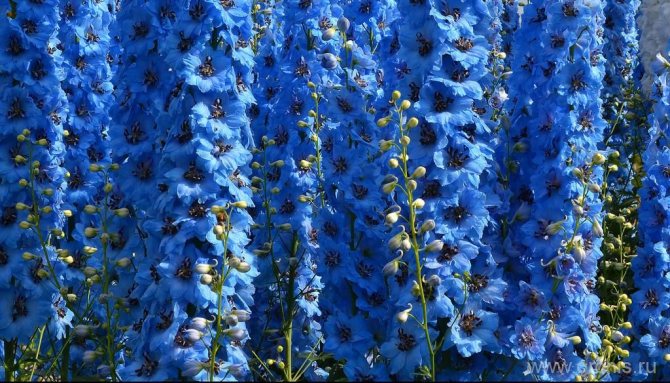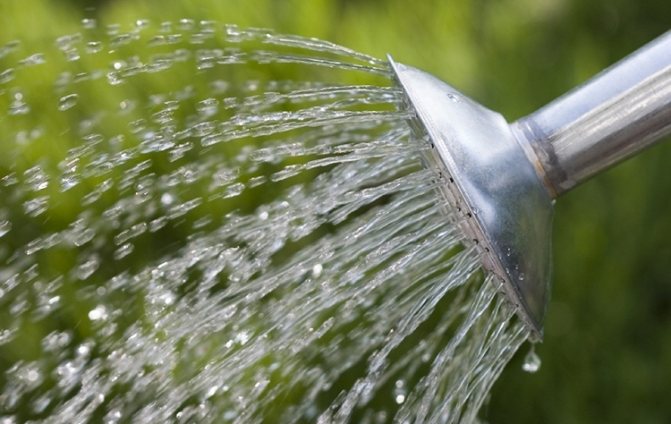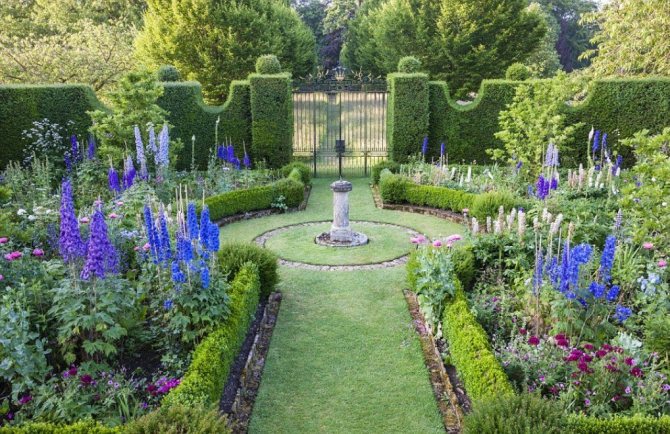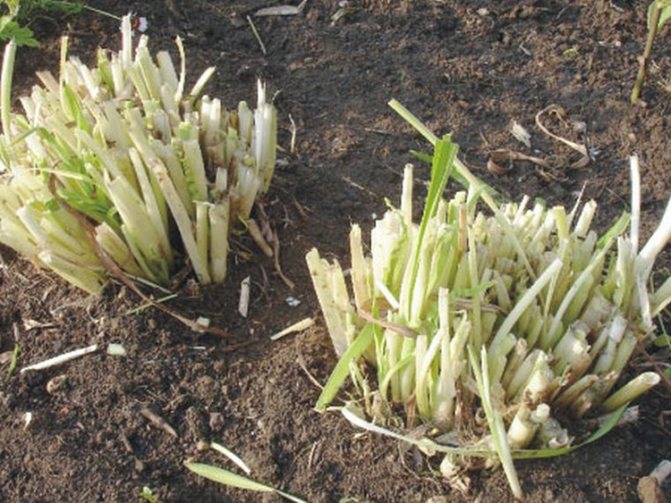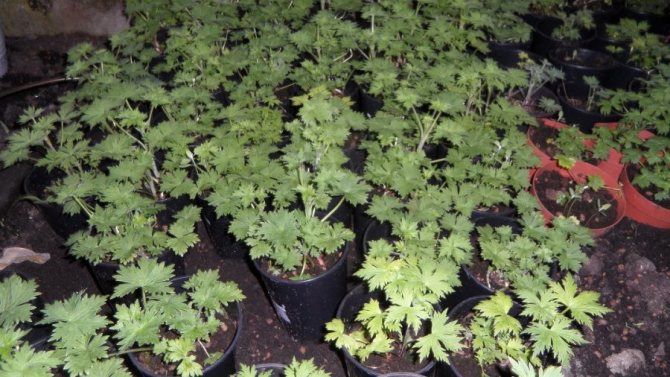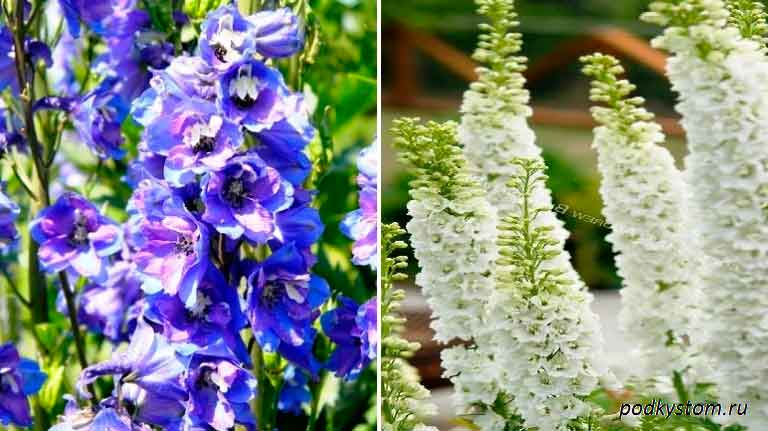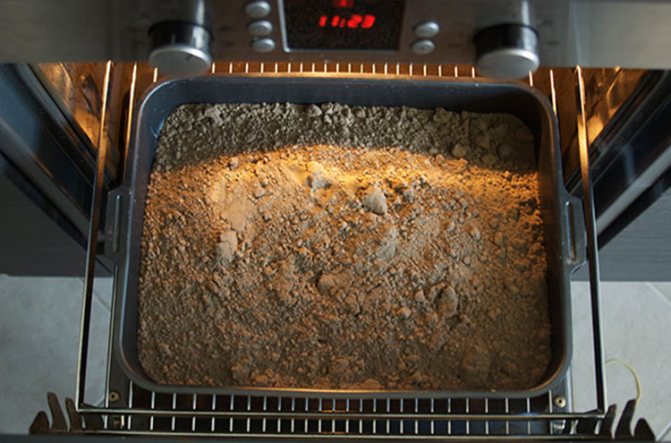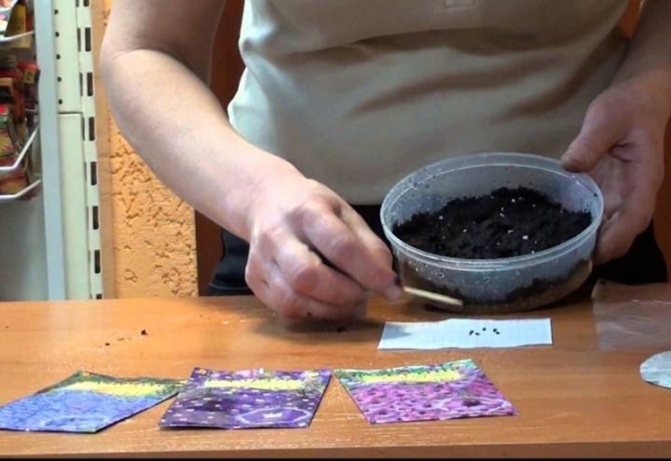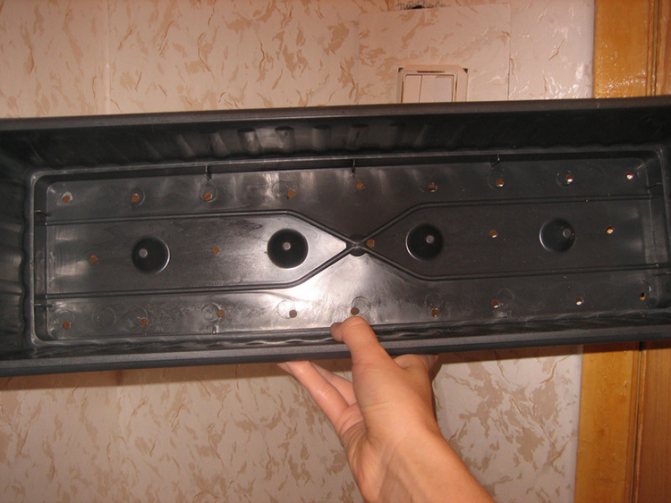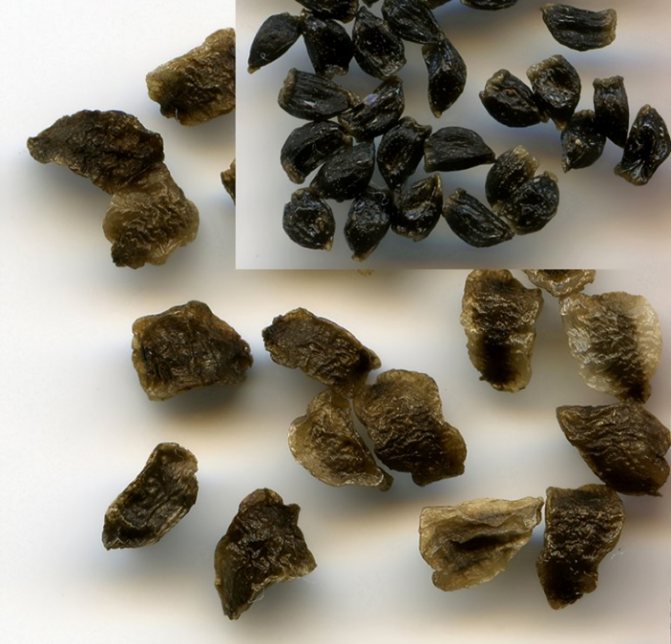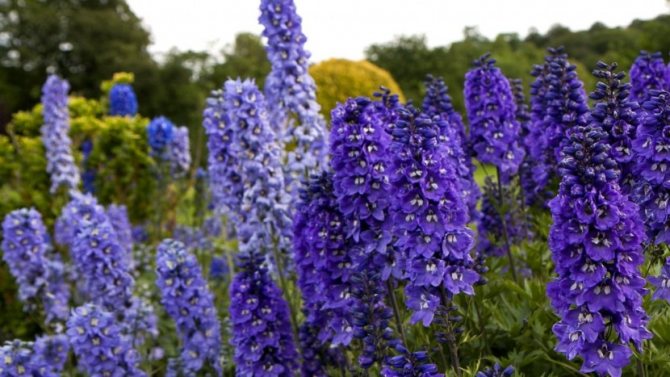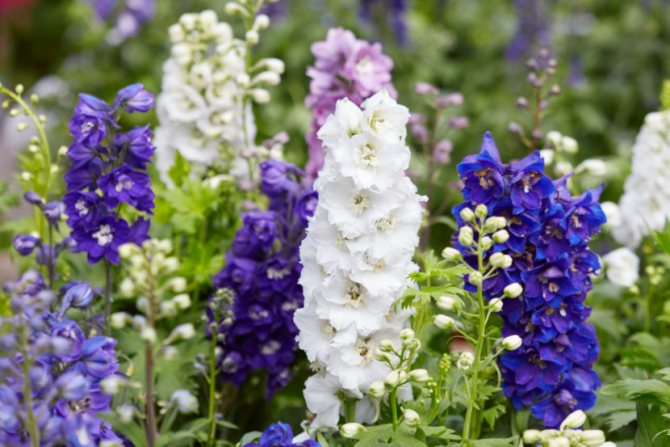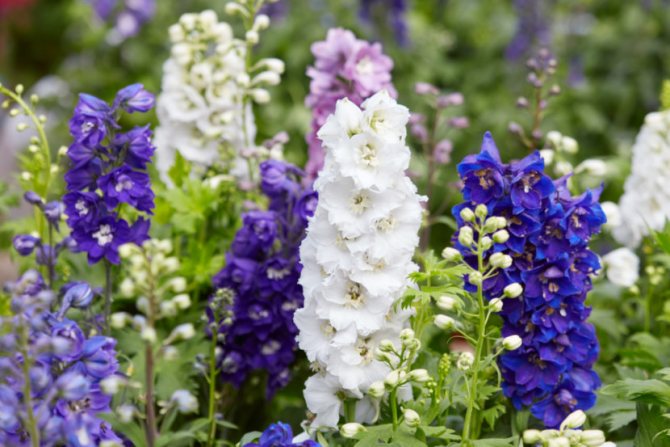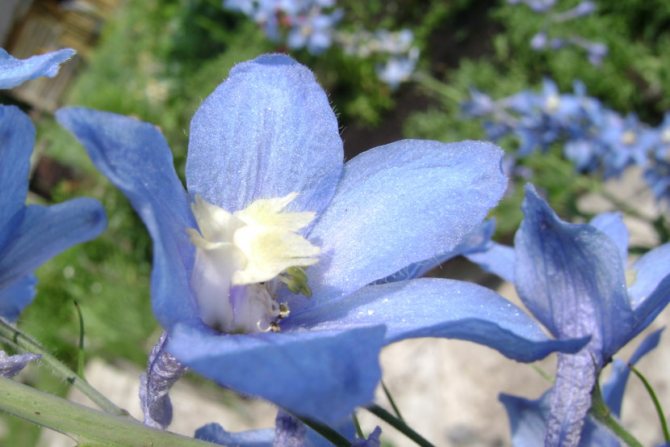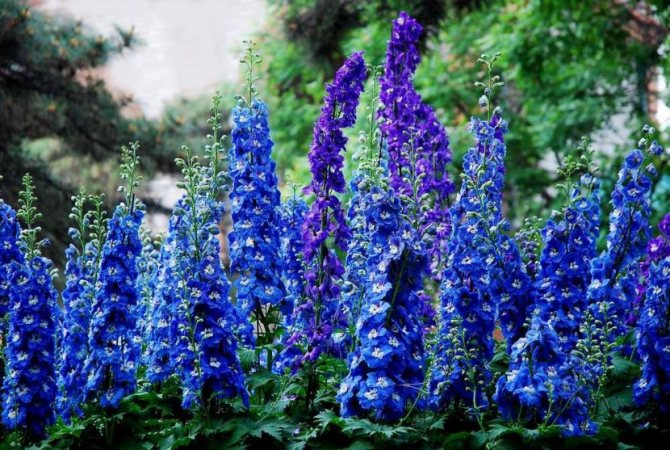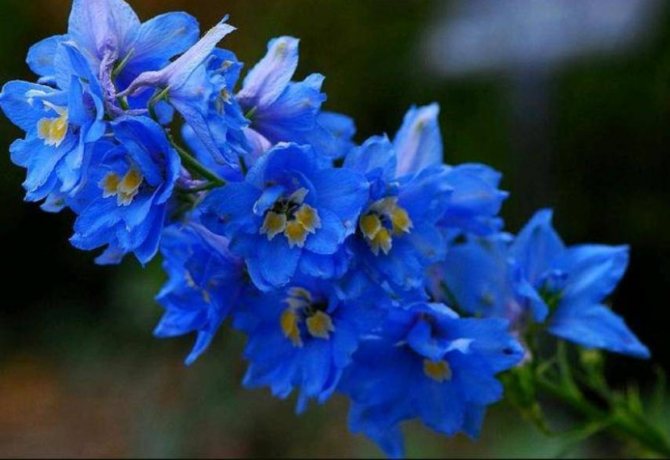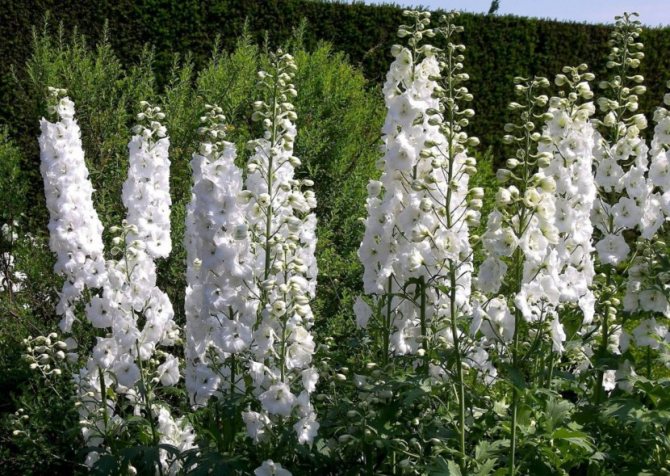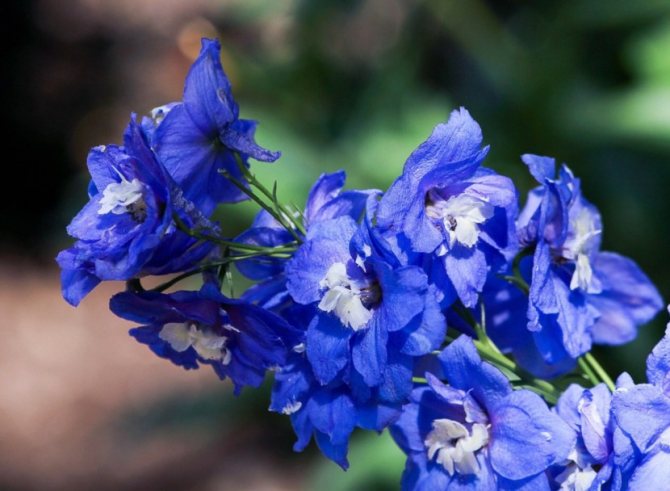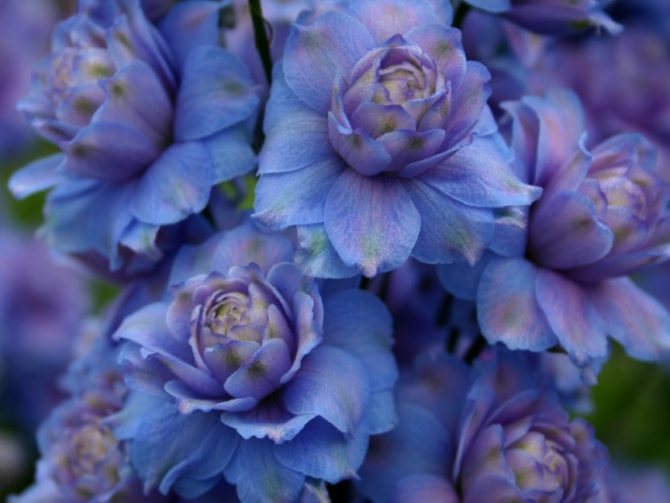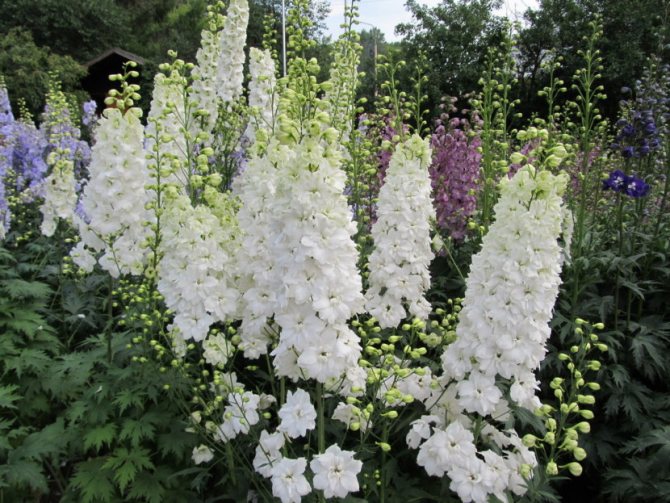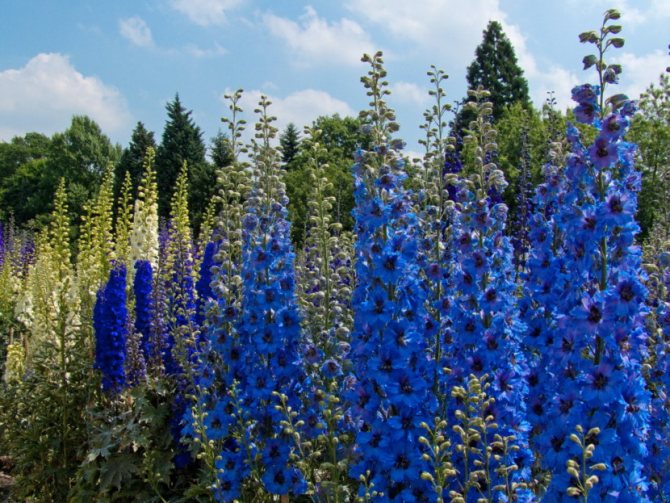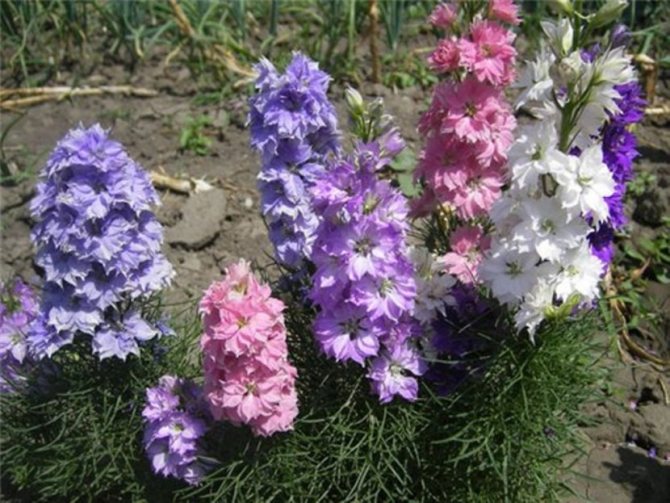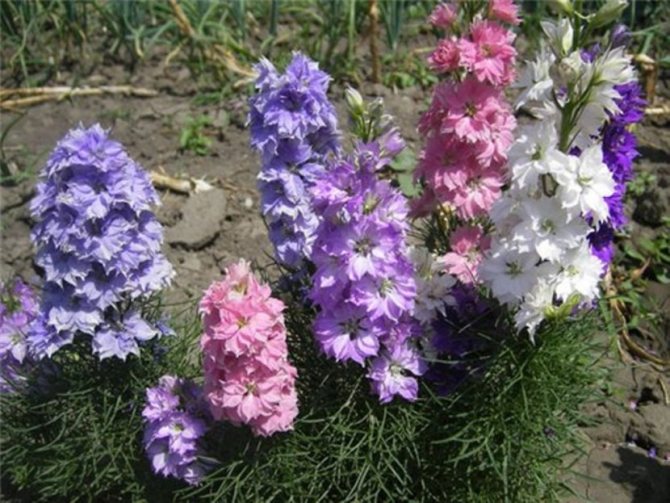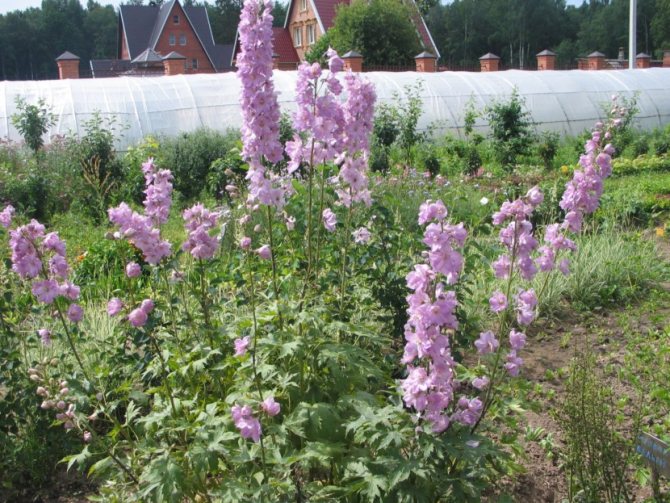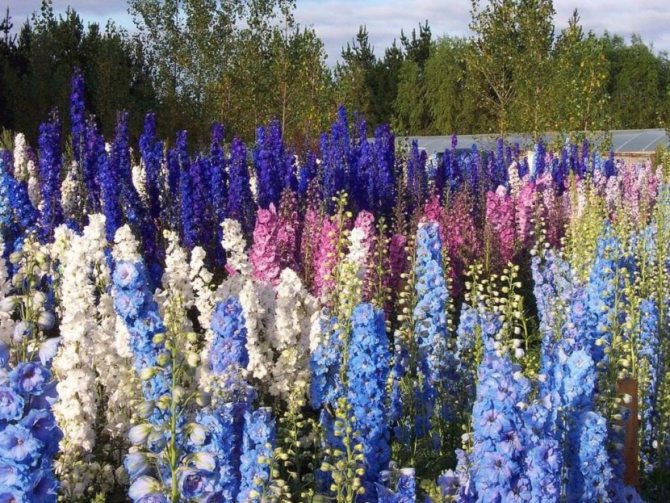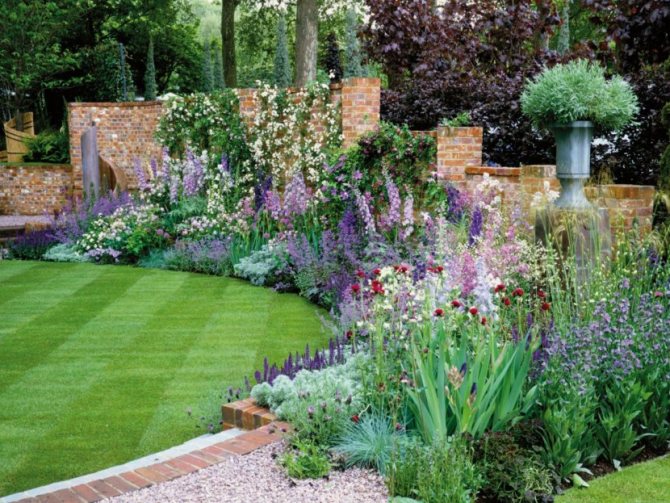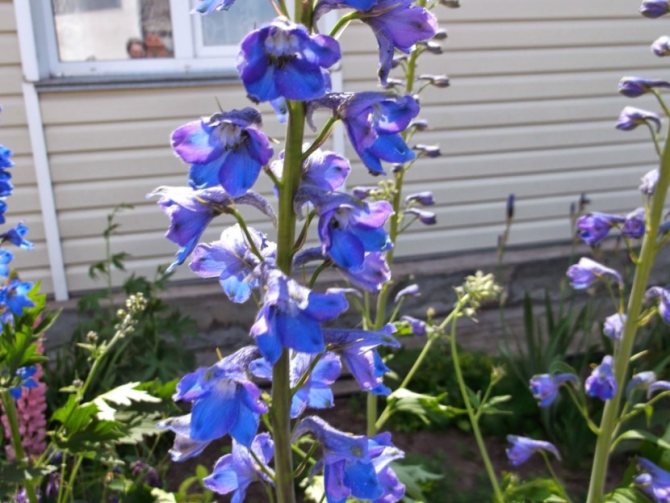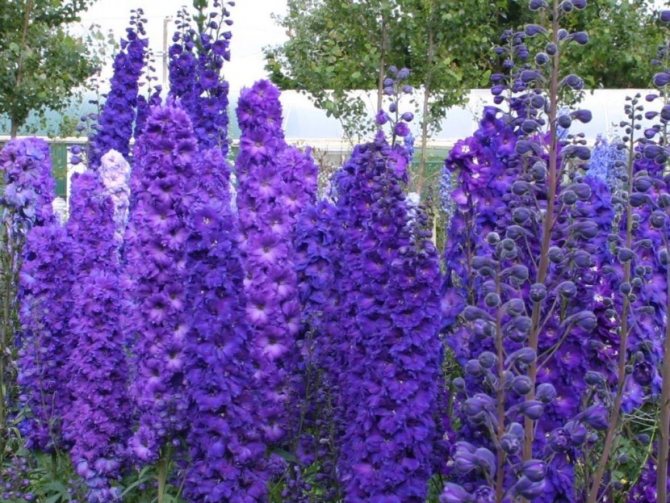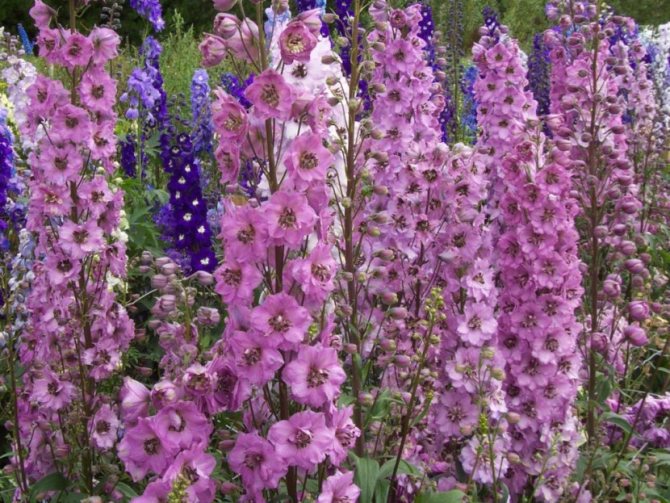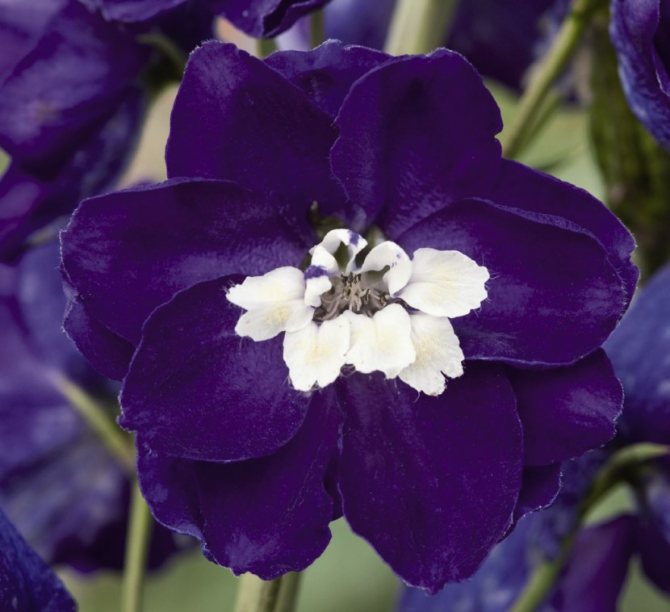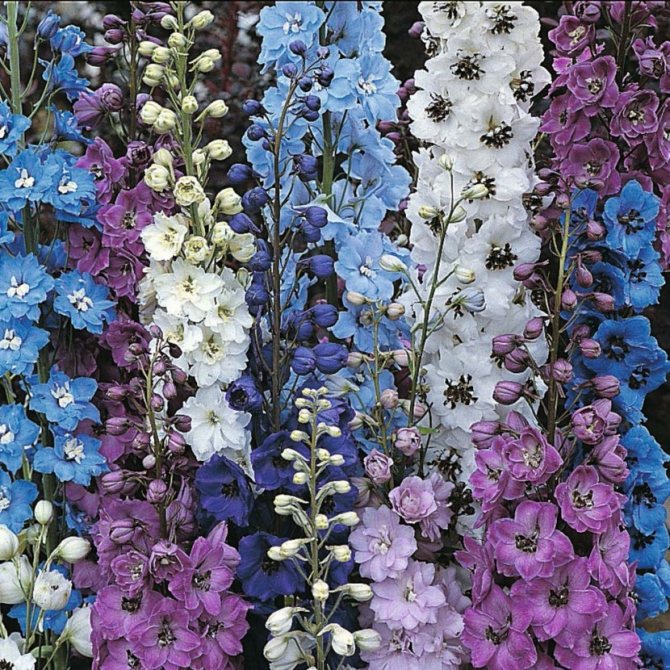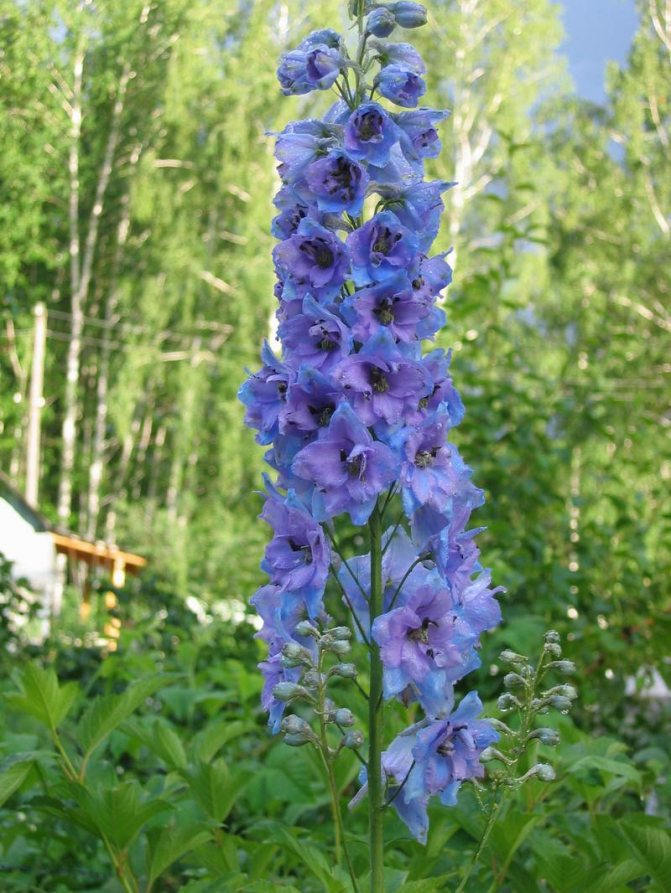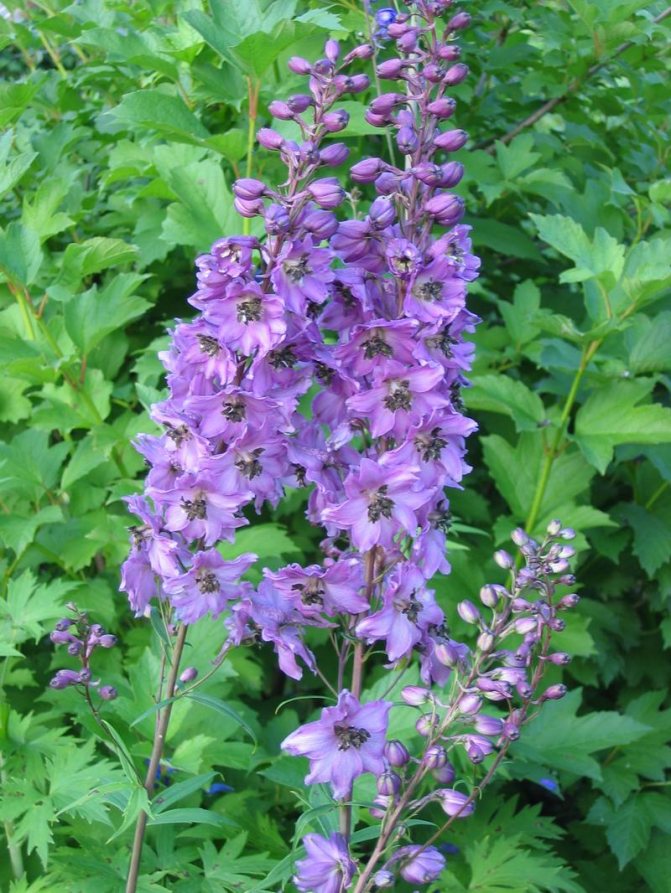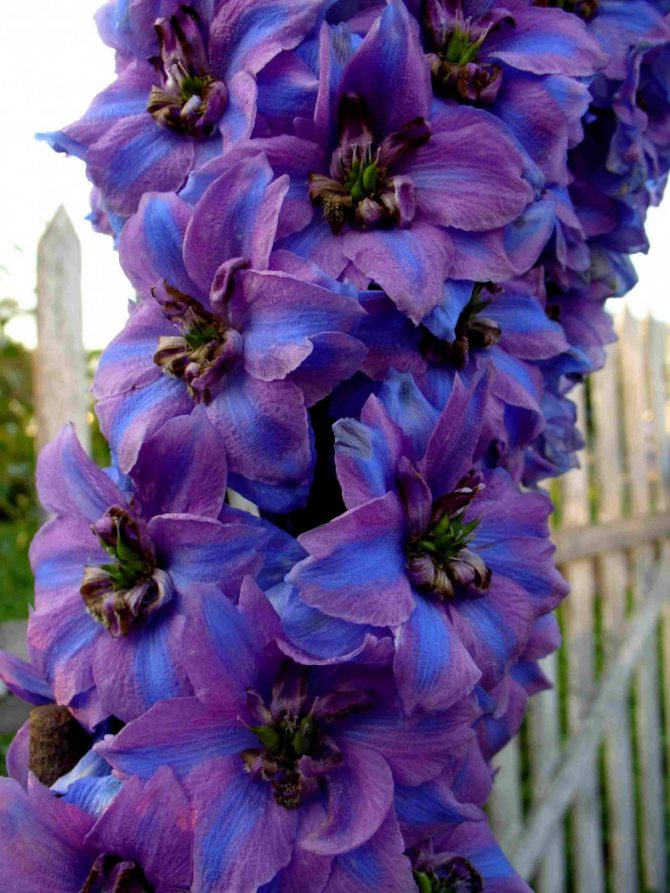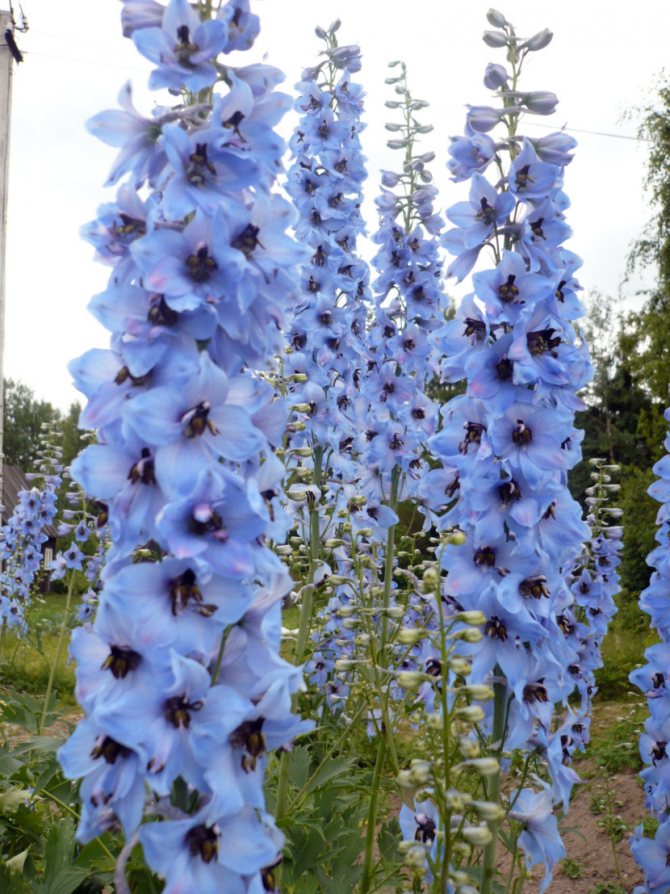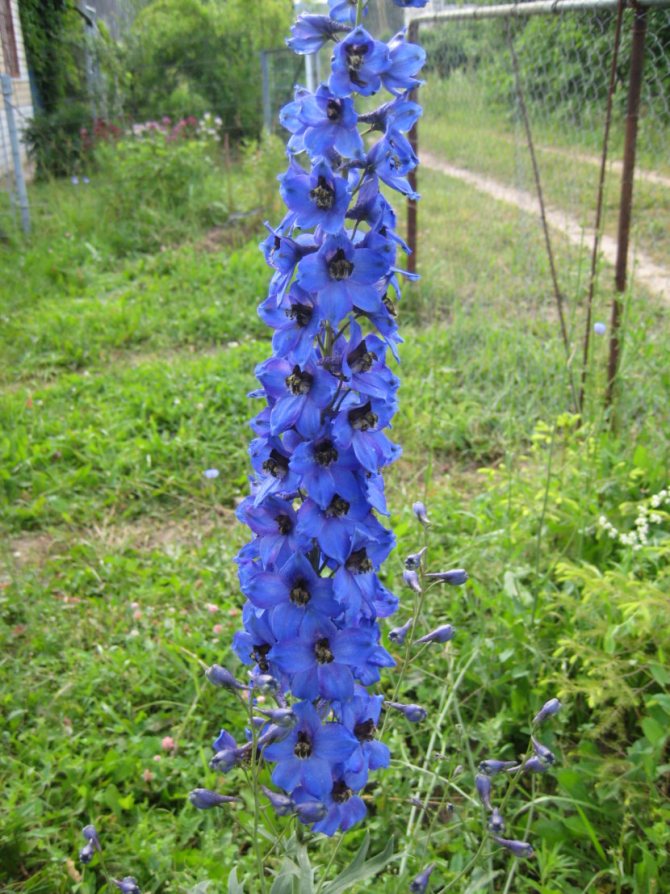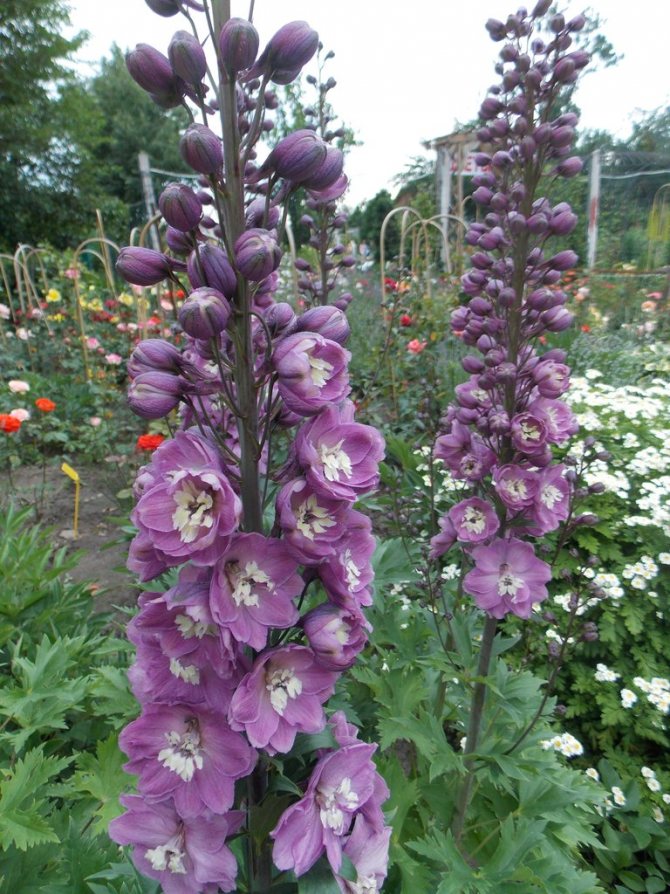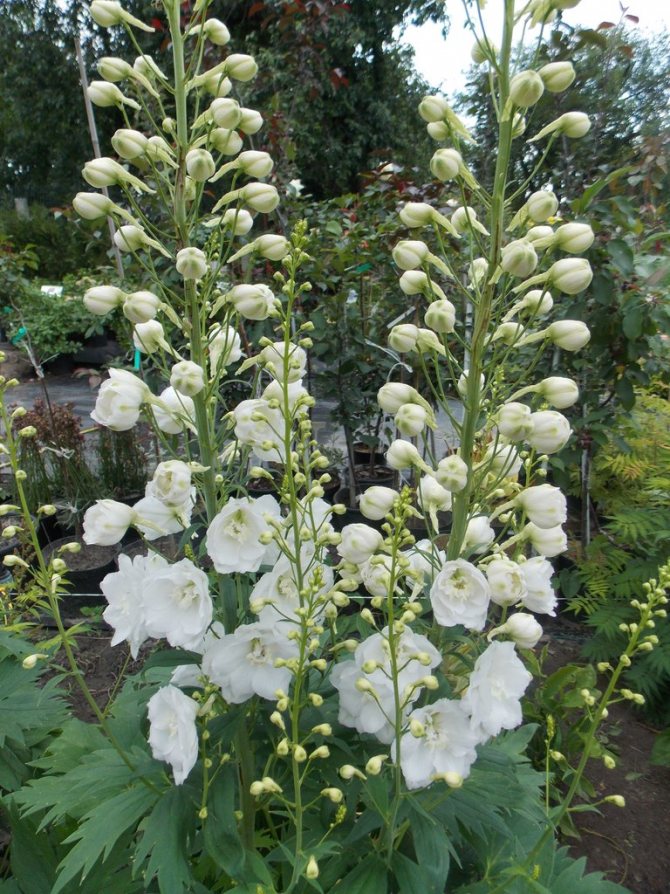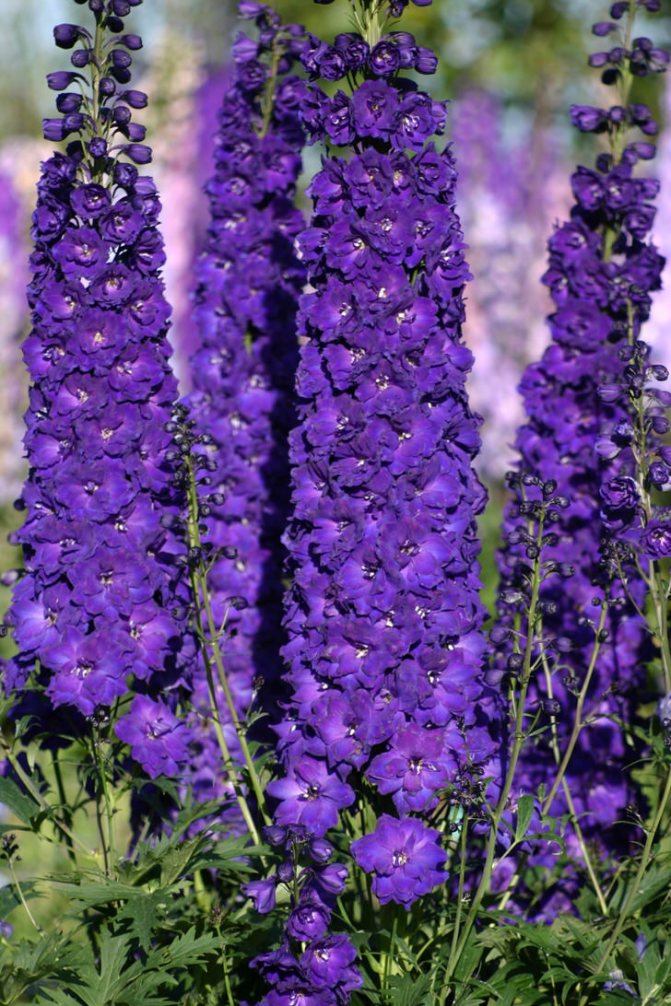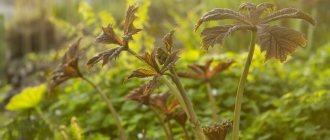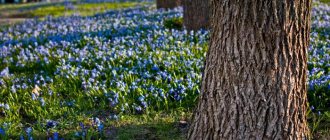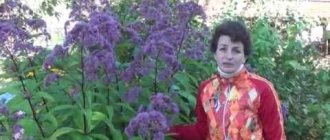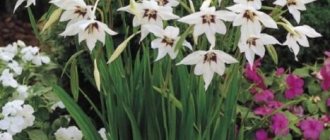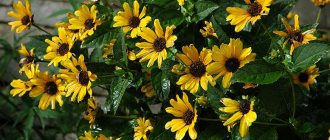Delphinium rightfully claims to be the royal place in the garden. Seeing this powerful tall plant in full bloom makes it impossible to remain indifferent. Like giant candles, they rise in candelabra of openwork leaves. Flowers, like light butterflies, completely cover the stem of the plant to a height of 70-80 cm.The color is very diverse: boiling white, pale pink, sky blue, purple and even bright cornflower blue, which is quite rare in nature. At the stage of dissolution, when small buds appear, as if floating in the air, the whole wide bush becomes like an exquisite Venetian lace.
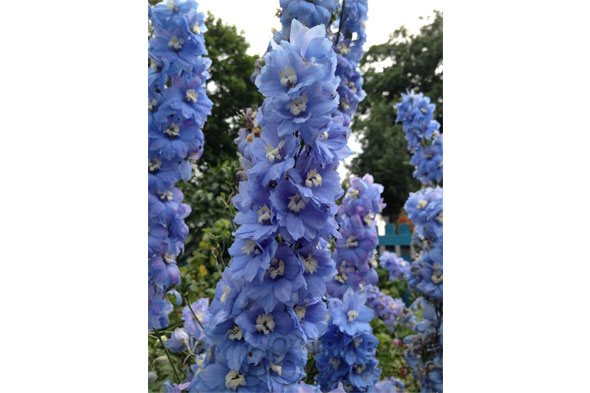
Delphinium or as it is also called Larkspur (Spornik) is a perennial plant, although there are also annual varieties, so be careful when buying seedlings. In total, there are more than 450 species of these plants. Plant height reaches 150-200 cm, flowers are collected in loose spike-shaped inflorescences up to 80 cm long. It blooms in June-July, in case of pruning, the second wave of flowering occurs in August-September. Flowers are double, semi-double or simple. In simple flowers with 5 petals, the upper petal has a process - a spur, where nectar is collected, hence one of the names of the delphinium arose. The root system is racemose (tuft), without the main root.
The plant is drought-resistant and frost-resistant, in one place it can grow up to 6 years.
However, it can suffer from prolonged rains, flooding, snowless winters, frequent thaws and sudden temperature changes.
Attention! All aerial parts of the plant are poisonous, so wear gloves and wash your hands when working with it.
Features of the
It is not easy to grow a delphinium, as it has certain characteristics.
- Buttercup family. It is often called larkspur or larkspur. A related variant is included in a group called sokirki.
- The buds are large. They can grow up to 2 meters.
- Inflorescences grow along the shoot and resemble a candle.
- Shades: blue, blue, purple, white, lilac, red and pink.
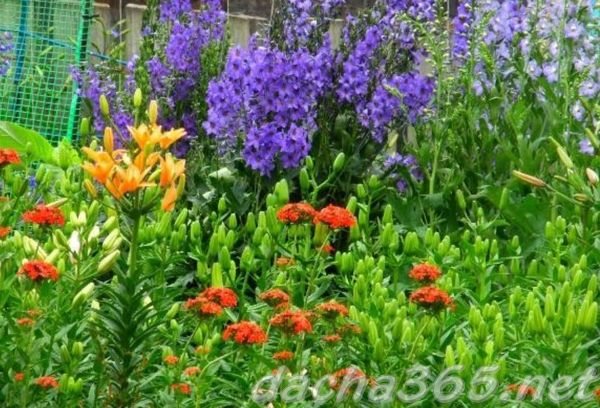

Interesting! The flower was named so because it resembles a dolphin when unopened. Or in honor of the city of Delphi, where it grows at every turn.
- The plant should be illuminated by the sun until lunchtime, it must be protected from strong gusts of wind and stagnant water so that rot does not appear.
- After planting, the soil is mulched with humus or peat.
- It grows in one place for 5-6 years, and Pacific species - no longer than 3-4 years. Then the plants are dug up, divided into parts and planted in new places. Hollow shoots require a garter as they grow.
- May be susceptible to powdery mildew and harmful insects.
- Perennial species begin to bloom in June. Duration 2-4 weeks. In the inflorescence, about 50-80 flowers are collected, they begin to bloom from below.
- Re-flowering is expected in August - September, but its duration is much shorter.
- Most often grown from seeds.
There are many varieties and types of delphiniums and they all have their own differences, so it is difficult to choose one. However, if the plot is small, it is better to choose 2-3 varieties.
Landing technique
Successful germination of seeds and further care of seedlings completely depend on the accuracy of the technology.
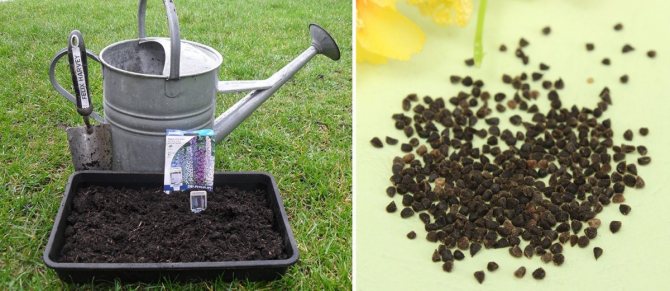

Photo: collage <>
Sowing seedlings
In order for the capricious "king of the flower garden" to please with rapid flowering from the first year, follow these instructions in sequence:
- Sowing dates are determined. Sowing begins in February, if there is equipment for supplementary lighting of seedlings, otherwise they are waiting for an increase in the duration of daylight hours.
- Pre-sowing seed treatment is carried out.
- Select containers for sowing. Rapidly decaying individual pots where a single seed is sown are not the best option. The root system of the seedling will not immediately master the soil, which can lead to acidification. Optimally sow in shallow seedling containers with drainage holes.
- On a note! Disposable food packaging is a good option. If it has already been used, it must be disinfected.
- Prepare the substrate. Purchased soil is suitable: universal for seedlings or for succulents. Peat, garden or garden soil, humus or compost, sand (2: 4: 2: 1) are mixed independently. The mixture is sieved, perlite is added (1 glass / 10 l of soil mixture).
- The soil is disinfected by heating in the oven for an hour. Purchased soil is spilled with a solution of "Fitosporin" or "Fitolavin".
- The containers are filled with the prepared substrate, lightly ramming it.
- Seeds are laid out on the surface, without deepening, without pressing down.
- Sprinkle with a thin layer of soil mixture or vermiculite.
- Cover or tighten with cling film.
- The container with the crops is placed in a dark, cool place.
Spur shoots appear by the middle of the 2nd week. Gardeners advise checking the crops daily from 6-7 days in order to immediately transfer the seedlings to a warmer place. The film or cover can be removed.
Seedlings are grown under the following conditions:
- moistened soil;
- the duration of daylight hours is 12-14 hours;
- temperature regime 18-20 ° С.
Seedlings dive at the stage of two true leaves. Place the sprouts in separate small cups. The substrate is taken as for germination, adding a full mineral complex to it, 2 tablespoons / 10 liters of substrate.
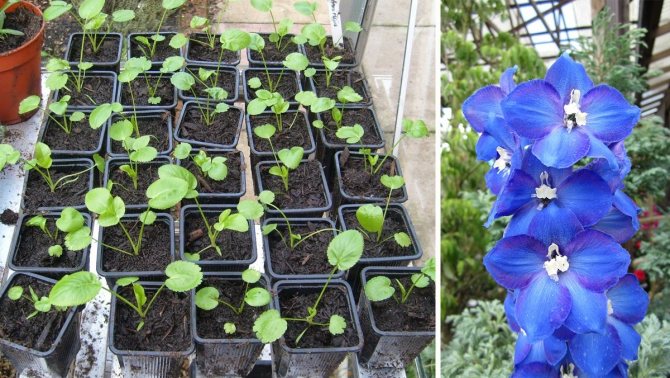

Photo: collage <>
After the pick, the temperature and light conditions are not changed. The first watering of seedlings is carried out in a week, if the soil was abundantly moistened during the transplantation. Before planting on a flower bed, seedlings are fed with complex mineral fertilizers (Agricola, Fertika Plus, etc.) every two weeks.
Attention! Top dressing is root, when the solution gets on the leaves, it must be immediately washed off with water.
Sowing in the ground
Direct sowing of burgundy seeds is carried out from the second half of April. For this, a special school bed is prepared:
- the soil is dug to a depth of about 30 cm;
- make complex fertilizers;
- make shallow, about one and a half centimeters of the groove;
- spill abundantly with water;
- seeds are laid out in the grooves;
- sprinkle with dry substrate.
In order for the seeds to sprout faster and more amicably, the crops are covered with agrofibre or a black (dark) film. Crops are periodically moistened, preventing the soil from drying out. The shelter is removed after the emergence of shoots - at 3-4 weeks. In the first season, the seedlings are watered moderately, fed twice a month, loosened the soil and remove weeds. For the winter, the school bed is covered with spruce branches so that the young plants do not freeze. In the spring of the second year, young shoots of burgers are transplanted to a prepared permanent place.
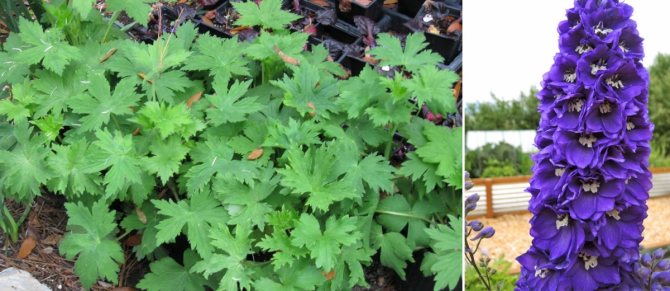

Photo: collage <>
Types and varieties
Ajax
The plant up to 100 cm in height was bred by crossing two varieties of delphinium. Sessile leaf plates with a dense section. Inflorescences grow up to 30 cm in length, can be of different shades.
There are also dwarf varieties up to 35 cm in height. They bloom in terry buds of different colors until the very frost.
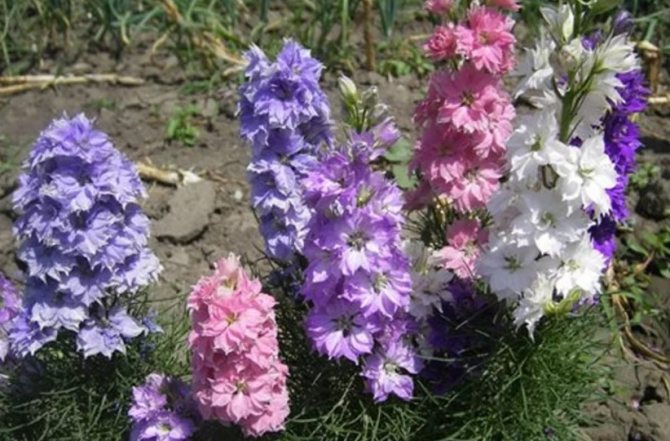

Field
An annual flower up to 2 meters high, which began to grow back in 1572.Forms simple or lush terry buds. The shade is classic. Blooms in June and blooms until early autumn.
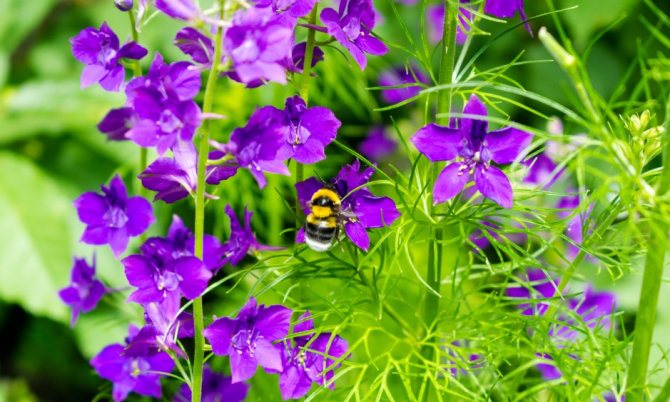

Delphinium perennial
Perennial varieties of delphinium began to be bred in the 19th century. The main feature of perennial varieties is the unique color of the buds. They can be:
- Various shades - about 800 variations.
- Inflorescences are simple, double and semi-double.
- The diameter of the flowers is from 2 to 9 cm.
- Different heights - short, medium and tall.
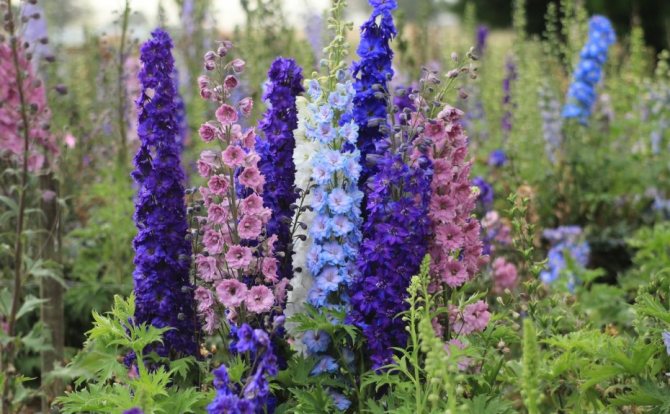

They can be roughly divided into five types.
Mafin group
Flowers of the Mafin group tolerate low temperatures well. They are especially decorative, grow up to 160-200 cm and have a strong stem. Inflorescences are large, semi-double with contrasting spots. Were bred by the breeder from the village of Mafino, Moscow region.
Interesting! In 90% they retain varietal properties, even if they are called hybrids.
These include varieties:
- Pink sunset.
- Morpheus.
- Blue lace.
- Snow lace.
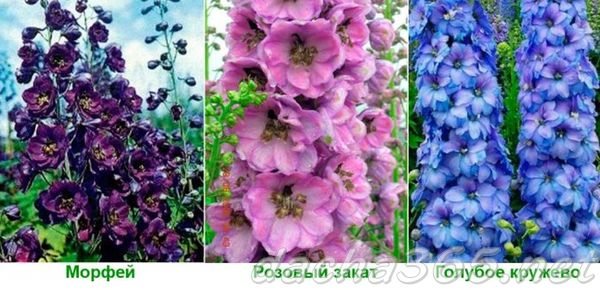

The collected flower seeds of the Mafin group do not retain varietal characteristics, therefore they must be purchased from the originator.
New Zealand group
They grow up to 200 cm in height. They produce double and semi-double flowers, some may have corrugated petals. Flowers are not susceptible to disease, resistant to low temperatures, well preserved when cut. The most common types:
- Pagan Purples.
- Sunny Skies.
- Blue Lace.
- Green Twist.
They never go out of style.
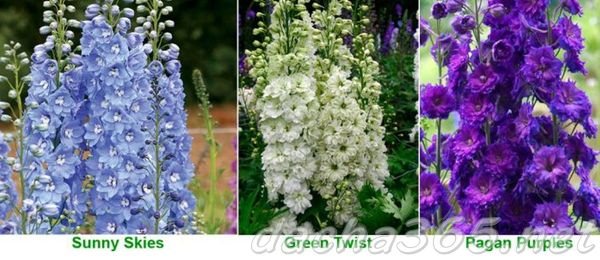

Belladona
The only species with hanging panicles.
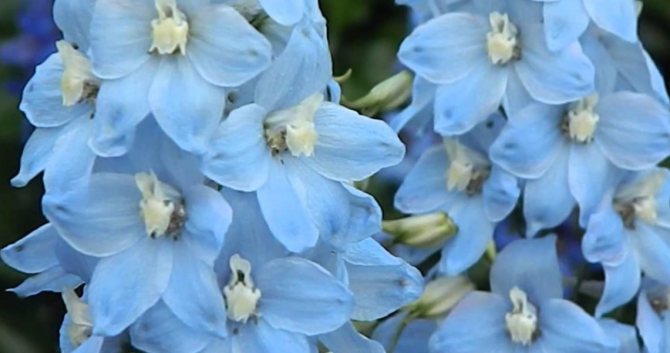

Pacific hybrids (Pacific)
Large bushes with dense shoots grow up to 180-200 cm.Inflorescences are semi-double up to 1 m.
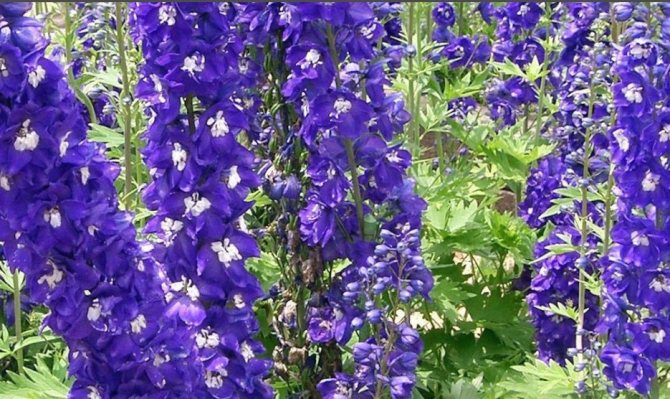

Elatum
This species has blue inflorescences - from pale blue to deep purple.
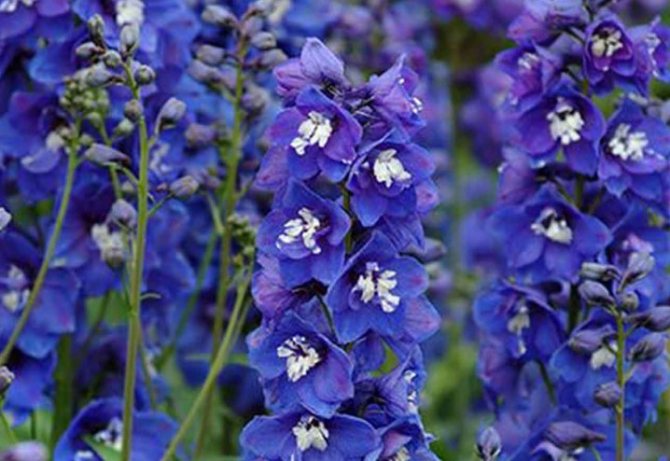

New Zealand hybrids
They are distinguished by large semi-double or double flowers, collected in dense brushes. The color is bright, monochromatic.
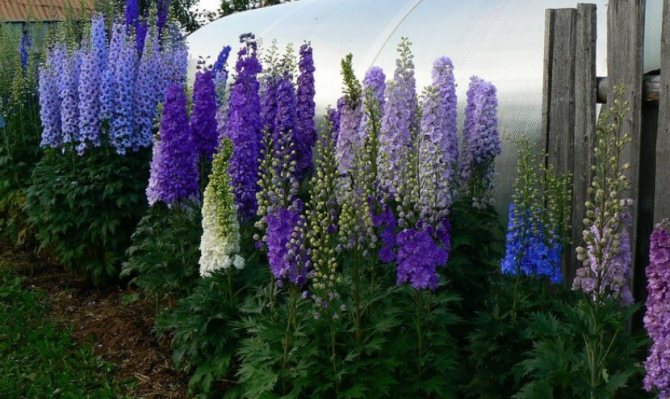

Each group has 15-20 varieties.
Description of the plant
Impressive, tall delphinium (larkspur) inflorescences are an excellent decoration for summer flower beds. The Latin name comes from the word delfinion and refers to the structure of the flower, the buds resemble the nose of a dolphin.
Perennial delphinium flowers belong to the buttercup family. It can be found in China, Siberia, Mongolia, Europe. In nature, plants are found on the outskirts of forests, meadows, stream banks, mountain meadows. Numerous hybrids are grown in our gardens - annuals, perennials, 80-200 cm high.
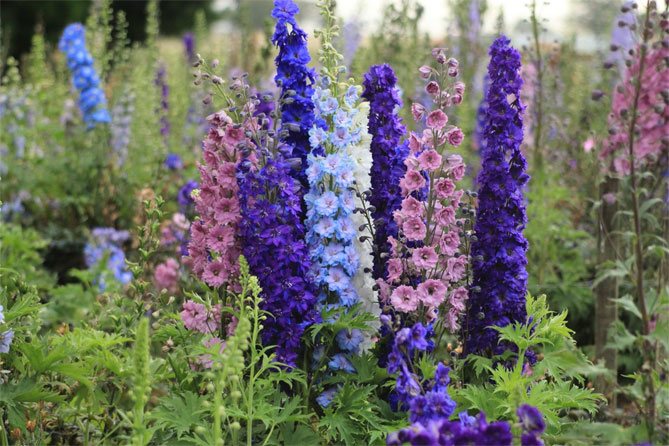

The plant has tough, erect, non-branching stems - pubescent and non-pubescent. Leaves are palmate-pinnate, large, toothed, on long petioles, located opposite each other, forming a rosette. Plants form thick, fibrous roots.
The main decoration of perennials is flowers, usually blue or purple, white, pink, two-color, pastel or bright. The inflorescences are located at the top of the stem, collected in long clusters - up to 100 centimeters long!
Individual flowers are arranged on long stems, usually 4-6 cm in diameter. The upper sepal leaf creates a long transverse process, similar to a spur (hence the other name of the plant - spur). Delphinium flowers are simple or double, appear from mid-June to July, melliferous.
Attention! Many delphiniums are poisonous. May cause food poisoning, vomiting, blurred vision, difficulty breathing if eaten.
Sowing seeds directly into the ground
Delphinium seeds can be sown immediately in late March - early April in a greenhouse to get flowering plants in the first year of sowing or outdoors in May. Sowing can also be carried out before winter or in winter in boxes. They are buried under the snow, and in the spring the seeds sprout together. A pick is carried out when 2-4 leaves appear on the seedlings.
Important! Planting should be regularly watered and fed.
Seed propagation is rarely used, since most hybrids grown in this way do not convey the decorative qualities of the parent flowers. However, you can immediately grow several flowers that are excellent in their qualities.
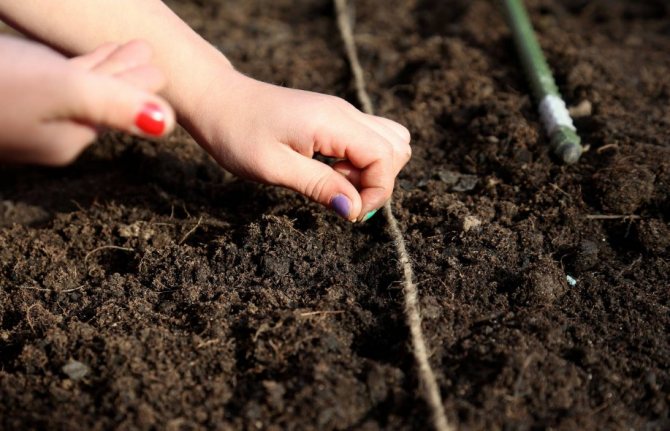

Interesting! Most hybrids are propagated by cuttings. They are taken from the lower part of the peduncle in early spring.
Content
- 1. Selection and preparation of seed 1.1. Presowing treatment of delphinium seeds
- 3.1. Optimal sowing time
A tall, stately, bright delphinium (popular names - "larkspur", "larkspur") will give originality to the lawn or flower bed, will become a spectacular decoration of the yard. Powerful stems with inflorescences of lavender, pink or aqua - this is the delphinium. Planting and caring for it is not difficult: the plant is unpretentious, grows well with a seedling and seedless growing method and can be one of the first successes of a novice gardener.
Cuttings
Young shoots about 10 cm long are used as cuttings.
- The lower cut is treated with a root stimulator. For these purposes, an ordinary agave is suitable. In an adult aloe, the bottom leaf is torn off and kept in the refrigerator for 5 days.
- Next, the lower parts of the cuttings are moistened with aloe juice.
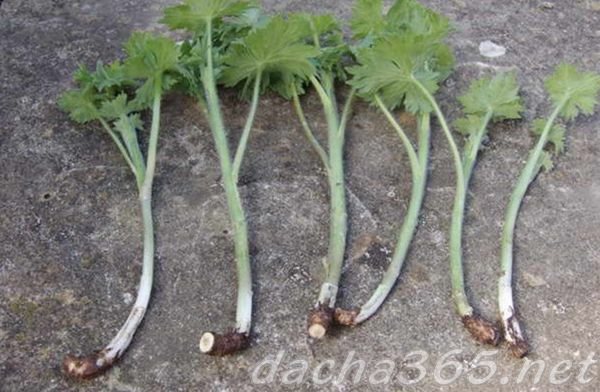

- Cuttings stick well-moistened sand or vermiculite. You can use Kornevin and similar agents.
- Containers with cuttings are covered with foil to maintain moisture.
- When the cuttings take root, they will put out new leaves.
- The grown seedlings are transplanted into open ground at the end of summer, so that they have time to adapt and take root before the cold snap.
Important! Delphiniums tolerate winter well in Central Russia, the main thing is to cover them with sawdust or dry peat.
Selection and preparation of seed
Basically, through the seed, the annual delphinium is propagated. Growing from seeds is optimal for the popular in Russian latitudes Ajaxov's Delphinium, various "hyacinth" varieties.
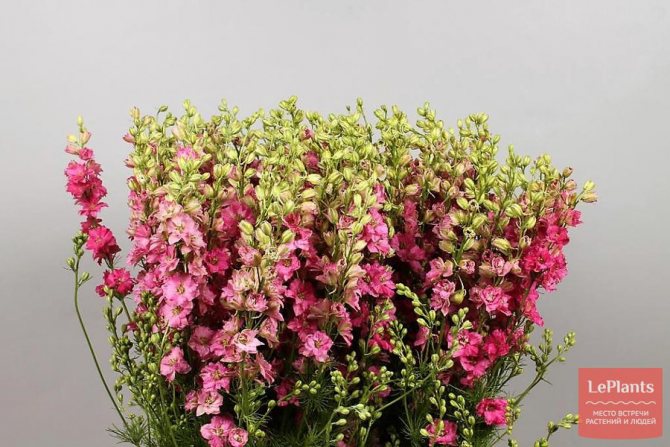

ON THE PICTURE: Dark pink Delphinium Ajax.
It is advisable to propagate Pacific hybrids only by seeds (Pacific), bred in California. These include varieties:
- ‘King Arthur’;
- ‘Black Knight’;
- ‘Astollet’;
- ‘Galahad’;
- ‘Blue J’ etc.
When propagated by seeds, such delphiniums retain 60–90% of varietal traits, which is important for those who collect delphinium varieties or are simply a big fan of it.
Another method of reproduction - vegetative (by cuttings, buds, division of rhizomes) - is suitable for perennial species of delphinium, growing from seeds of which carries the risk of losing varietal traits. Propagated directly from the parent plant, young bushes receive all its varietal features and characteristics, including: color, flower shape, habit (appearance) and even resistance to certain diseases! Also, in a vegetative way, densely doubled varieties of flowers that do not form seeds are bred.
The seeds are purchased in the store or harvested by hand in early autumn, when they are ripe.
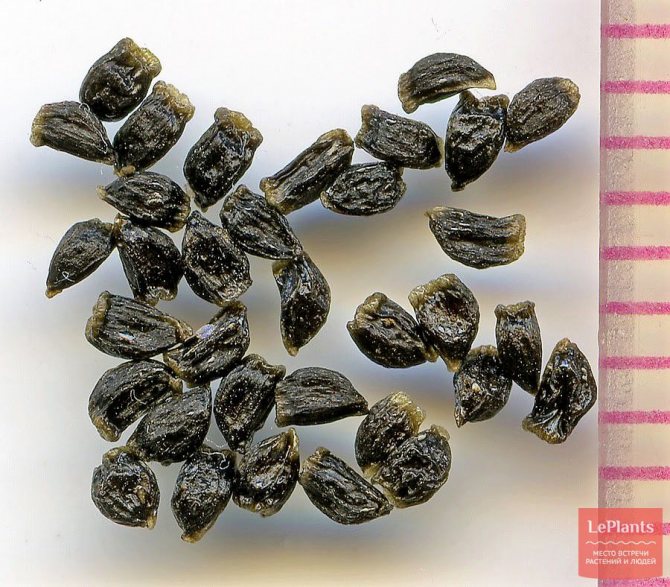

ON THE PICTURE: Delphinium seeds.
One plant with four inflorescences can produce up to 2.5 thousand seeds. This is quite a lot, especially for small or compact delphinium varieties. Therefore, in order to protect the parent plant from depletion, when the seeds ripen, they leave only the lower part of the inflorescence and 10-15 leaves.
A considerable problem in the long-term cultivation of delphiniums from seeds in the same place is their self-seeding.To avoid unauthorized "sowing" near parent plants, you need to collect seeds immediately after they ripen and do not allow ripe "seeds" to spill onto the ground.
After harvesting, the seeds remain viable for two to four years (if stored in a cabinet). If you put the seed in the refrigerator, hermetically sealed the jar with it, its germination will be preserved for an unlimited time.
Presowing treatment of delphinium seeds
Powdery mildew and fusarium are dangerous for delphiniums. They also have leaf spot. To prevent infection of plants with these diseases, it is worth treating the delphinium seeds before sowing for seedlings. To prevent bacterial wilting, they are kept for 25-30 minutes. in water with a temperature of 50 ° C. Additionally, before planting, the seeds are treated with fungicides: Topaz, Fundazol, Maxim.
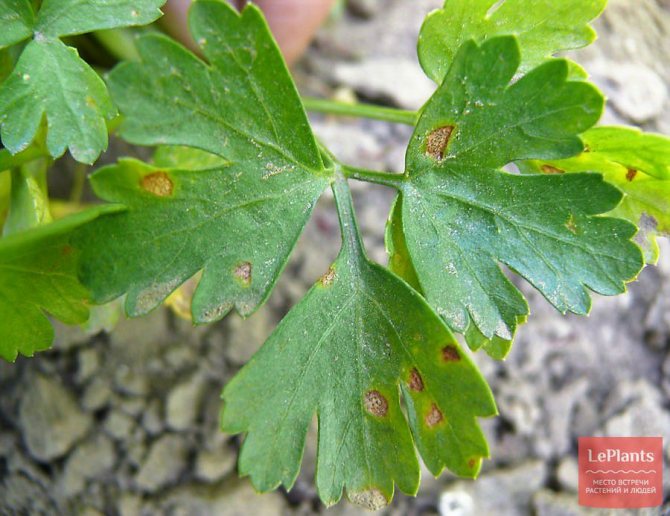

ON THE PICTURE: Plant leaf spot.
Care
When the plants grow up to 10-15 cm, they are fed with mullein solution. For 1 bush:
- 20 liters of water;
- 2 liters of fertilizer.
After loosening the soil and removing weeds, the flowers are mulched with peat or humus, making a layer of 3 cm.
When the plants grow up to 20-30 cm, they need to be thinned out. Choose 3-4 strong stems, and break off the rest or cut off at the surface of the soil. Thus, the inflorescences will become larger, and the bush will be better ventilated.
Trimmed cuttings with a heel can be rooted, as long as they are not hollow. The cut is treated with crushed tablets of heteroauxin and charcoal.
When the plants grow up to 40-50 cm, 3 supporting rods, 1.8-2 m high, are dug in near each bush. The shoots of the plant are tied to them with a soft rope so that it does not crash into the stem during a strong wind. When the shoot grows to 1–1.2 m, it is tied up again at a new height.
During the growth of the bushes, they need about 6 buckets of water. If the summer is hot and dry, then once a week each flower is watered with 20-30 liters of water.
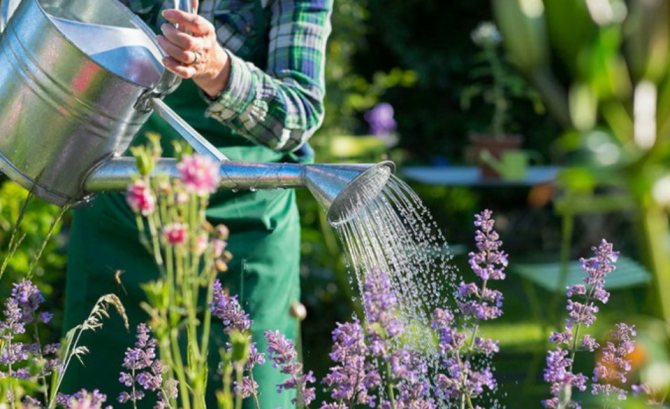

When the soil dries slightly, the top layer is loosened 3-5 cm in depth.
When forming inflorescences, the bushes are watered abundantly. So that areas with no flowers do not appear on the plants, the delphinium is fed with phosphorus-potassium fertilizer
20 g of superphosphate per 10 liters of water, 1 liter of solution is poured under each bush.
Versatile use in landscape design
Delphinium is versatile in application - suitable for various types of gardens:
- rural,
- eastern,
- naturalistic,
- forest.
Larkspur garden hybrids are a great proposition for rural, English and eclectic gardens.
Tall varieties of larkspur are planted near fences, walls, small objects of architecture. From a few to a dozen are planted on ridges, planting in the background as a background for undersized species.
Low varieties are suitable for random planting in different parts of the flower bed, rabatka. You can grow them in containers as a decoration for balconies, terraces, porches.


Delphiniums of different species are perfectly combined with each other, and with many perennials:
- peonies,
- geraniums,
- lupines,
- decorative garlic,
- yarrow,
- echinacea,
- helenium,
- sunflowers,
- daylilies,
- chrysanthemums.
Varieties with cornflower blue flowers look beautiful in the company of red poppies, yellow daylilies, pink foxgloves, white daisies. White-flowered varieties should be planted next to yellow rudbeckia, pink echinacea, scarlet lobelia and delicate ornamental grasses. Delphinium can be used to create a one-color rabat, for example, with only white or blue flowers. Classic combinations with roses look attractive.
Spurs look great alone, in large groups, against the backdrop of a lawn, house walls, fences. You can create lanes along sidewalks and walkways.
Large, tough flowers are suitable for cutting, keep freshness in a vase for a long time. Cultural delphinium (Delphinium cultorum) is used for vases.Flowers should be cut when the inflorescences are half developed. Then they stand in a vase for 3-6 days.
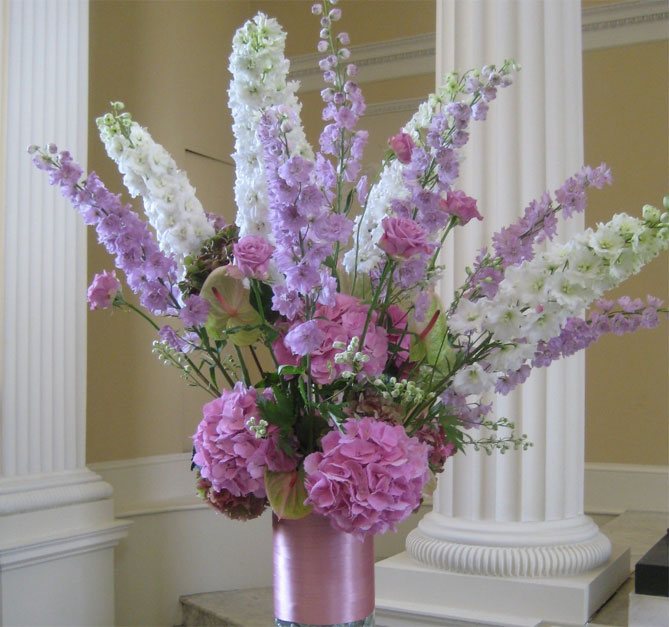

Although delphinium flowers are gorgeous and very showy, they will not stay in the flower bed for too long, so they should be planted among plants that will cover the empty spaces left by the magnificent spur flowers with flowers or leaves.
Dividing the bush
At the end of flowering, the inflorescences are pruned and seeds are collected if necessary. After that, young stems will appear and in the fall the delphinium will bloom again. Between flowering at the end of summer, you can divide the bush, which has been growing for 3-4 years or more. The plant is dug up and cut with a sharp knife or cut into pieces.
Important! During division, the main thing is not to damage the renewal kidneys.
The sections are treated with wood ash and the cuttings are planted.
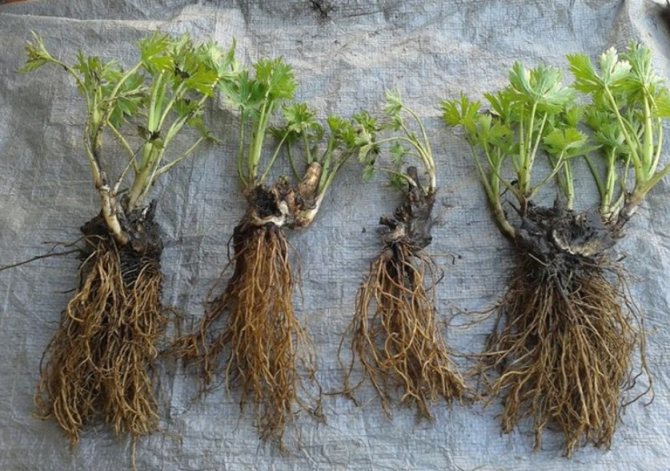

Reproduction methods
Like all herbaceous plants for open ground, delphinium can be grown from seeds, cuttings and a "cut" of rhizomes.
Reproduction of a perennial delphinium by division
Dividing the rhizome of a mature burgundy is the simplest, and therefore popular, method. The age of a plant suitable for division is 3-4 years. Older or younger bushes tolerate the procedure worse. The division is carried out:
- in spring, when fresh leaves begin to sprout;
- in the fall, when the seeds begin to ripen (and new foliage grows again).
The root is carefully removed from the soil, keeping the largest earthen lump as possible. Break or cut it with a sharp instrument, leaving a bunch of roots, one young shoot and one dormant bud on each division. This is enough for the young plant to quickly build up its green mass and prepare for flowering. "Delenki" are seated in prepared places. Until autumn, they are carefully looked after, and covered for the winter.
Reproduction of the perennial delphinium by seeds
A description of the process of growing a burgundy from seeds is given above. Let's add a few words about the collection and storage of seeds. Delphinium seeds are easy to tie, but of different quality. To minimize the loss of time and effort for germinating unpromising seeds, they resort to the following technique: 10-15 lower flowers are left in each inflorescence candle, the rest are cut off. So that the ripe seeds (they should ripen at the root) do not crumble, the peduncle is wrapped in a thin cotton cloth or gauze in one layer. Ripe seeds are stored in glass jars or foil bags at a reduced temperature. Seeds collected on their own do not always inherit the varietal qualities of the parent plants; for fans of experiments and surprises, this serves as an additional incentive.
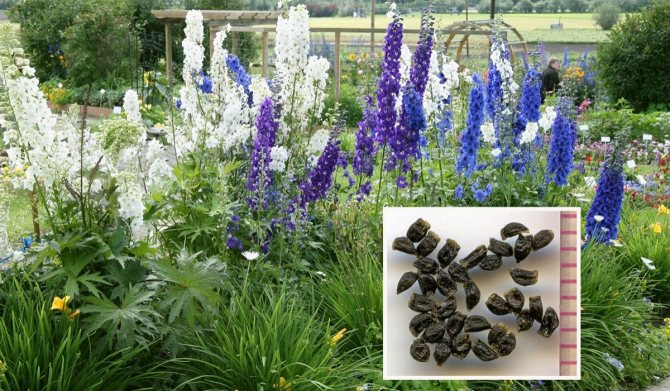

Photo: <3.bp.
Reproduction of delphinium by cuttings
Apical cuttings are taken for reproduction. Prepare them in the spring, cutting out young 10-centimeter shoots. Separate from the uterine bush at the very root collar with a piece of root tissue. Larkspur cuttings are rooted in a substrate consisting of peat and sand in a 1: 1 ratio. Deepen by 2 cm and cover with a transparent cap. Conditions for successful rooting: shading, temperature 20-25 ° C, high humidity. The process takes about 5-6 weeks. The cuttings are transplanted to a permanent place in the spring.
Note! "In group cultivation of delphiniums, the distance between plants is maintained at least 30 cm."
After flowering
Shoots are cut when the leaves of the faded plant are dry. Leave only 30-40 cm from the surface of the earth. The top is coated with clay so that moisture does not get into the hollow shoots and cause rotting of the root system.
Delphinium is a frost-resistant plant even in the first year of life. If in winter there is little snow in the region and the temperature is below freezing, the plants should be covered with straw or spruce branches. Delphinium can die only with a sharp change in temperature due to decay.
Advice! As a preventive measure for stagnant water, it is initially recommended to pour 0.5 buckets of sand at the bottom of the planting pit.
Pests, diseases and methods of control
Diseases:
- root collar rot - Hom (40 g - 10 l), 1% solution of copper or ferrous sulfate (10 g - 1 l of water), Bordeaux liquid (30 g - 1 l of water);
- rust - collection and burning of infectious shoots and treatment of plants (Fitosporin, Skor (2 ml - 10 L), Hom (40 g - 10 L), Topaz (4 ml - 10 L), 1% solution of copper or iron sulfate (10 g - 1 liter of water), Bordeaux liquid (30 g - 1 liter of water);
- powdery mildew - powder the leaves with wood ash and wash it off after two days, Skor (2 ml - 10 l), Pure flower (2 ml - 5 l of water);
- wilting (wilt) - foundation 0.2%, previcur 0.2%;
- curl leaves - 1% solution of copper or iron sulfate (10 g - 1 l of water), Bordeaux liquid (30 g - 1 l of water); timely removal and burning of diseased, dry, old and broken leaves and shoots.
Pests:
- spider mite - spraying with water; Fitoverm, 1 ml per 0.5 l of water;
- aphid - Spark KE, 5 ml per 5 liters of water; Biotlin, 5 ml per 10 l of water; infusion of garlic, nettle; urea, 20 g per 10 l of water; scare away aphids by nasturtium and lavender;
- onion fly - Spark, 1 tab. - 10 liters of water; powdered mustard or hot peppers;
- slugs - Thunderstorm, granules; Metaldehyde, granules;
- caterpillars - Iskra KE, 5 ml per 5 liters of water; Herald, infusion of garlic, nettle.
Preparing the soil
Best of all, the annual delphinium grows in such a soil mixture:
- Garden land - 2 parts.
- Compost or humus - 2 parts.
- Peat - 2 parts.
- Sand - 1 part.
The finished soil mixture is sieved, a little perlite is added to impart friability and moisture capacity (1/2 glass of perlite for every five liters of soil). Additional sterilization will not hurt - for this, the soil mixture is heated in a water bath. The soil is poured into a container and lightly tamped.
Next, the prepared seeds are carefully sown on the surface, the substrate is poured on top with a thin layer (3 mm), lightly rammed. It is better to water with a spray, the water should be cool and always boiled. Top can be covered with a transparent lid and black foil. In the dark, seeds germinate faster. Crops are systematically ventilated, and condensate is removed, watering is carried out.
Cut
Cut the peduncles in the early morningas long as the plant is in normal tone and the turgor (elasticity) of the leaves is well expressed. For cutting, those "plumes" are suitable, on which at least half of the buds have already opened.
Varieties of the Belladonna group with branched inflorescences-panicles stand after cutting the longest - up to 2 weeks. The slender and noble flowers of the Malyutinsky and Pacific hybrids will decorate any bouquet, but in the cut they are worse - up to 10 days. "New Zealanders", "Fosters" and "Africans" are in themselves a ready-made bouquet from one stem! However, their lifespan after cutting is the shortest - 5-7 days.
Take the same care when pruning as when transplanting! The person to whom the cut flowers are intended must be warned that the flowers themselves and the water after them can become a source of poisoning!
back to menu ↑
See also: Hydrangea (90+ Photos) - description, outdoor care, reproduction, transplant, disease (Video) + Reviews
How to propagate a delphinium
Delphinium is propagated vegetatively, by cuttings and dividing the bush, and by seeds. Seeds can be harvested from your plants. It must be remembered that seeds are not harvested from hybrids, because they do not transmit hereditary characteristics. As a result, the flowers will be of a different shade, size and shape. That is why the vegetative method is preferable.
Vegetative way
The most effective way to reproduce delphinium is vegetative. At the same time, the accuracy of repetition of the maternal properties of the plant is guaranteed.
Propagation by cuttings
Reproduction by cuttings is done in the spring. While you are removing excess shoots on mature bushes, you can start rooting them.The stalk is taken small, 15-20 cm, a small piece of the rhizome should remain at the bottom of the stalk.
Cuttings are rooted in a special "school", a container filled with a loose substrate. To increase humidity, cover it with a transparent lid. After the stalk is rooted, the lid is removed.
If this is not possible, cuttings are planted in the shade of bushes or trees, where they feel quite comfortable.
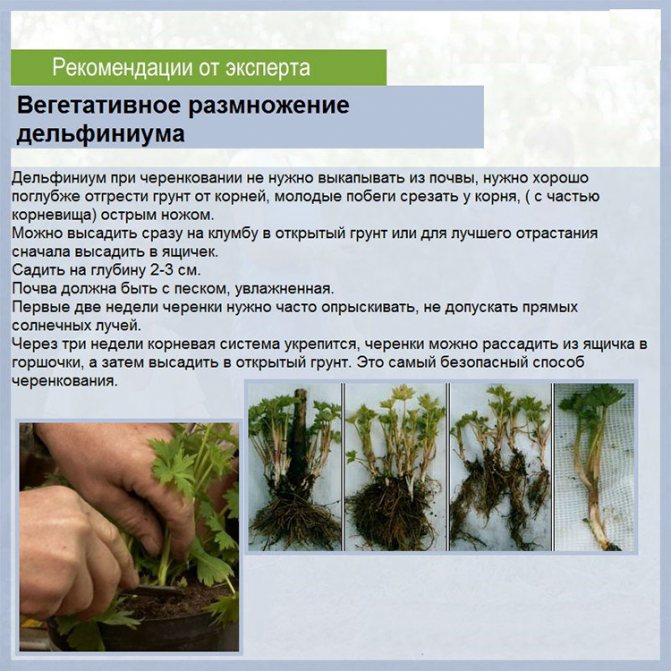

Reproduction by dividing the bush
Old bushes must be divided. Sometimes the division of the bush coincides with a transplant to a new place. In the spring, as soon as the first shoots appear, they dig up a delphinium intended for reproduction. The delphinium root is shallow.
We shake off the ground and examine the bush. Divide with a sharp knife so that each part has a central shoot that will bloom this summer, renewal buds (they will bloom next year) and a root system.
Plants are planted in a new place, observing the same rules as when planting seedlings. But in order for the plant to quickly restore the disturbed root system, it is shaded for a short time, for two weeks, from the bright sun.


How to achieve abundant flowering?
In order for the delphinium to delight you with lush and long flowering, regular feeding is recommended. If the soil is fertile, it can be applied 3 times a year:
- When the delphinium reached 20 centimeters in height.
- When the budding period began.
- Withering of flowers is observed.
Florists use saltpeter, superphosphate and other mineral complexes, they do not bypass organic matter. From time to time, the shoots are pruned so that they branch better, and the bush turned out to be thick. As soon as the vegetation reaches 30 centimeters, it is shortened by 10 centimeters. Withered inflorescences are harvested to induce re-flowering. When there are a lot of overgrown, it is high and fragile, you can drive in additional pegs for safety reasons so that the delphinium does not fall off.
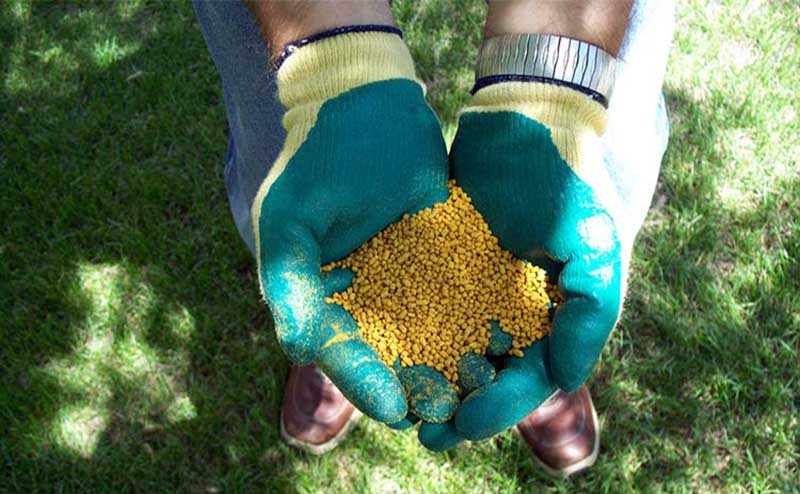

Delphinium feeding
Divide the rhizome
If you are already the proud owner of a 3-4 year old bush, then it is quite possible to start increasing the amount of culture on the site by dividing the rhizome.
How does this happen?
Prepare in advance the soil composition for planting from soil mixed with humus in equal proportions.
With the arrival of spring or autumn, carefully (carefully) digging out the rhizome, slowly, with a sharp knife, we cut between the buds or young shoots. We cut it in such a way that each part obtained is the owner of at least one bud or shoot, and most importantly, it is endowed with healthy roots.
One powerful rhizome can give us up to 10 parts.
We plant in the allotted place in prepared pits 50 cm deep and wide. Next season we admire the flowering.
It is in this way that they try to increase varietal crops to preserve their original shape, color or unusual appearance.
The legend of the delphinium plant
As a rule, you can read a legend about each plant. This bright representative of the flora is no exception. The ancient Greeks have a story about a talented sculptor who sculpted a statue of his deceased beloved. From great love, the statue of the girl came to life. The gods were angry with the sculptor for what he had done and turned him into a dolphin. The grieving girl often spent time on the seashore. And one day, at her feet, the dolphin threw a delicate azure flower. Since then, this plant has been called delphinium.
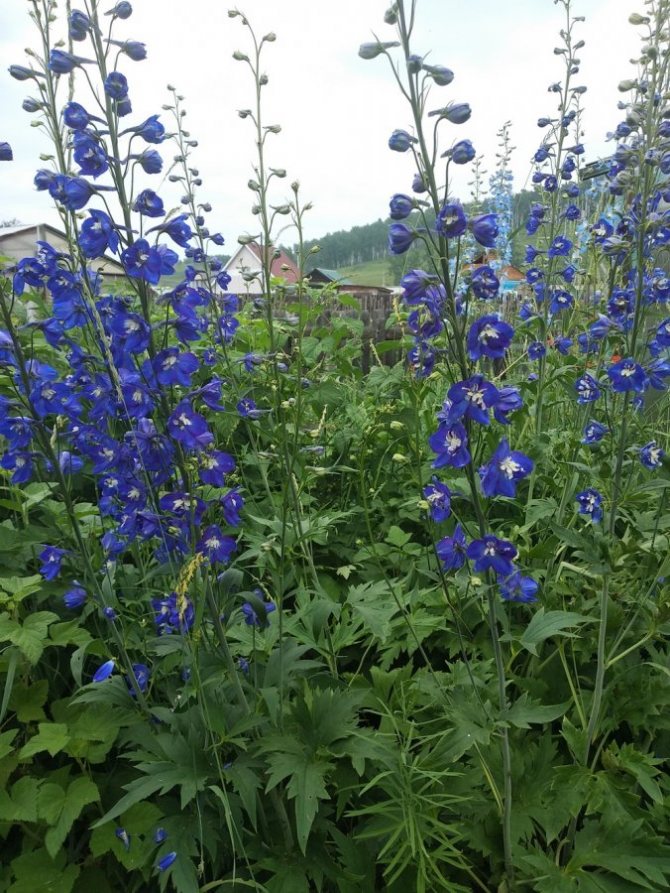

Grow, delphinium, big and small!
It is impossible to call a cultivated spur particularly fastidious, but you will have to follow some rules when growing:
- The landing site must be sunny
- "Greek grass" does not react well to the through wind
- "Delph" will perish if its roots are constantly blocked
- Mulching for a plant is a must for the development of a proper root system
- Tall hollow stems are breaking and require binding
- Re-flowering is possible with the complete removal of the first peduncles.
- With all its winter hardiness (up to 35-40 * below zero), the flower may not survive the first "joyful" spring thawed patches - the roots are too close to the surface of the earth.
- Pacific beauties require transplanting every 4 years, Marfinsky and New Zealand - once every 5 years, Elatums bloom quietly in one place for up to 7 years.
The first garter - the height of the stem is 40-50 cm. The second is 80 cm and more.
Do not use wire or twine as a binding material! Only ribbons, strips of fabric or fences!
back to menu ↑
See also: Badan: description, types and varieties, planting and care in the open field, medicinal properties and contraindications (60+ Photos & Videos) + Reviews
Top dressing, watering and loosening
To build up the green mass and abundant flowering of domesticated larkspur, proper feeding is required:
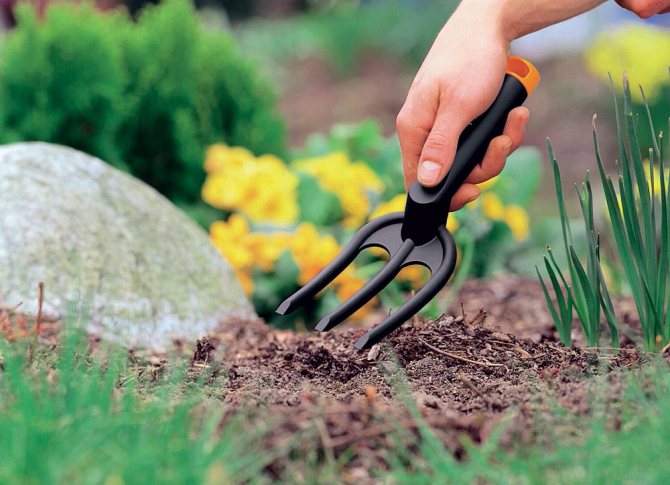

The soil under the bush must be loosened regularly!
But this must be done carefully, trying not to damage the small superficial roots, which grow up to half a meter from the base of the bush. The optimum depth is 5 cm.
In order for the bush to "breathe" freely not only by the roots, in the spring it is necessary to break off part of the shoots from the middle, removing weak and thin-transparent... These will not give a powerful flowering, they will only waste the "vitality" of the plant, but they will make good cuttings for propagation. In low-flowered species, no more than 10 peduncle stems are left, for multi-flowered species, 5 are enough.
All your efforts with feeding, thinning and loosening will not help the dolph feel comfortable if watering is insufficient. Watering must be abundant so that the water flows to the very bottom of the roots! Surface watering will do more harm than good.
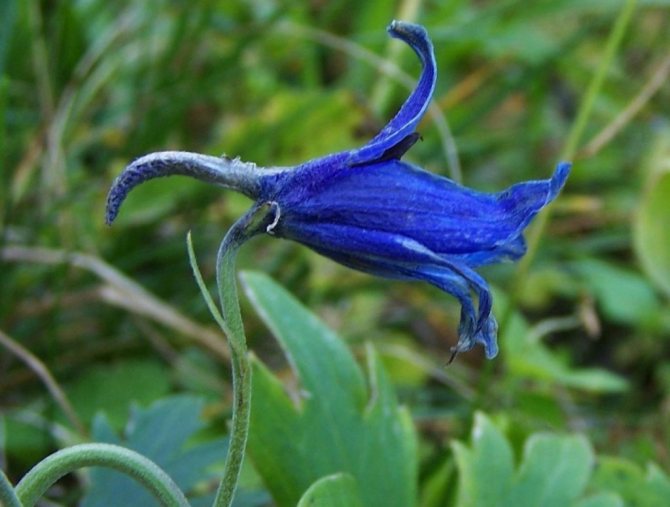

Delphinium oxysepalum
Plants suffer greatly from dry air, but they suffer no less if cold water shower them in a shower in the heat... Watering should be carried out in the late afternoon, when the heat subsides, and only at the root and along the "near-trunk circle" of 40-50 cm.
Lack of caring for a garden spur during budding often ends up simply dropping flowers.
Delphinium cannot be fed with dry or granular fertilizers! Only in aqueous solution! And, of course, after feeding - an abundant drink, as after taking a medicine.
back to menu ↑
See also: Barberry: description, types and varieties, planting in open ground, care, features for different climatic conditions including Siberia (65 Photos & Videos) + Reviews
Features of plant protection from pests and diseases
A planted burgundy often suffers from viral diseases, fungi or pests. Viruses are carried by aphids. Therefore, systematically carry out the prevention of its appearance. Spraying with insecticides helps from flies that lay their eggs in the stems and buds of the flower. The bacteria can cause black spots at the bottom of the leaves. The affected leaves must be removed, and other parts of the plant must be treated with tetracycline.
From powdery mildew and other fungal diseases, the plant can save the foundation. In order to avoid fungal infection, delphinium sprouts are recommended to be planted at a distance from each other, and also to monitor the correct watering. Leaves can be affected by ramulariasis. They are covered with large dark brown spots. After a while, they dry up and disappear. An antifungal drug is used to eliminate the disease. The leaves can also be damaged by the slugs that eat them. Slugs especially love to gnaw on young leaves of the plant. To combat pests, you need to regularly weed the weeds, and sprinkle the ground with potassium salt or superphosphate around the bushes themselves. Such means will prevent slugs from moving around the plants, and they will leave the territory.
Fertilization recommendations
The optimal time for the first feeding of the delphinium is early autumn,
when the ground is fully warmed up.For the procedure, it is necessary to prepare a mixture of 10 grams of ammonium nitrate, 70 grams of superphosphate, 30 grams of ammonium sulfate and 20 grams of potassium chloride. This amount of the mixture will be enough to fertilize an area of 1 m2. The granules are poured under the bush and covered with a small layer of soil.
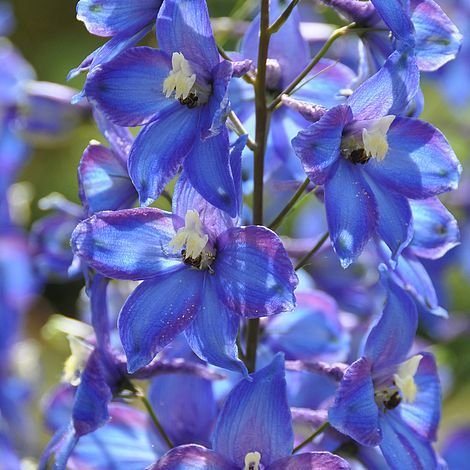

The second procedure begins at the time of laying the buds. This time, the mixture is prepared from 30 grams of potassium and 50 grams of superphosphate.
At the end of the summer season, it is recommended to fertilize the plant with the same composition as in the spring.
Botany, names and garden flowers of "Greek grass"
Larkspur (Delphinium) has about 500 species, about 100 grows on the territories of Russia and adjacent lands.
The most common are 2:
- Perennial Larkspur high (Delphinium elatum - lat.)
- Annual larkspur field (Delphinium consolida - lat.)
All of them are identified by botanists in the related genus of field Sokirkov (Consolida regalis) and they are all poisonous to one degree or another.
The concept of perennial for Delphinium elatum is somewhat overstated. The root of the plant dies off after 5-7 years, which means that the planting of perennial varieties of delphiniums, beloved by gardeners, must be renewed every five years.
If in the scientific and medical literature for a plant the name "spurnik" or "larkspur" is used, then the field "wild" specimens are called by the people semi-scientifically, but very affectionately - "sokiriki".
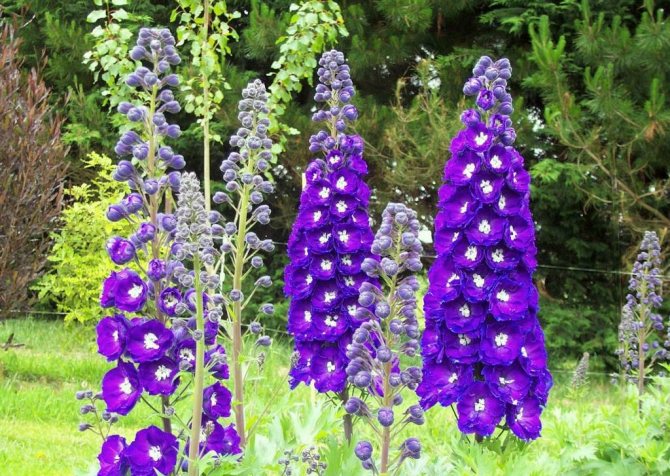

sort "King Arthur"
Gardening books and articles use the term delphinium. This is justified! - It is rare to find real sokiriki in the garden! Mostly they are grown not for their medicinal qualities, but for the beauty of their hybrid variants.
The burgundy hybrids really differ from the modest sokirik in the height of the stem, and the structure of the inflorescences, and the color of the petals, like a small bow-legged mongrel dog from Apollo among dogs - Great Dane.
back to menu ↑
See also: Wisteria: description, cultivation in the open field and features of caring for a whimsical beauty in different climatic zones (65+ Photos & Videos) + Reviews
Growing tips
Despite the fact that the delphinium is very easy to care for and plant, a few basic rules must be followed:
- The landing site should be well lit and protected from strong winds.
- Watering should be moderate, and in a rainy summer, you can additionally not water.
- Feed with fertilizers three times a season.
- Tall crops need to be tied up.
- Trim wilted flowers for the length of the flowering period.
- Cut in the fall and prepare for winter by covering it with a layer of dry leaves or burdock.
- They look harmoniously on a flower bed with any flowers.
Delphinium - a real find for gardeners and landscape designers. Ease of care and bright flowering allow it to occupy the first places in the ratings for cultivation. A variety of varieties will perfectly complement any garden and landscape, and will delight the eye with the beauty of their graceful flowering. Favorite and unforgettable flowers.
Planting delphinium seeds for seedlings
Consider how to plant a delphinium with seeds - spread the flower seeds evenly over the prepared soil. If you are using granulated seeds or a small amount of seeds, spread them out with tweezers. Delphinium variety labels will help you avoid confusion in growing a delphinium from seed. Sprinkle the sown seeds on top with soil, about 3 mm. Compact the sowing of the delphinium with seeds - pat your palm on the soil so that they do not float when watering. Spray the crops evenly with warm water from a spray bottle and cover the crops.
Since the delphinium grows better in the dark, there are two ways to cover the delphinium seedlings:
- black film or covering material;
- with an ordinary plastic bag and put in a dark place until the first shoots.
For germination, seeds do not need a high temperature, +10 degrees is enough. Sometimes at high temperatures, +20 seedlings may die.Plants respond well to cold, so for hardening when growing seeds, you can alternate the temperature regime - cold / heat. Seeds sprout 7 - 10 days after planting. Do not miss this time - you will need to remove the cover from the top. To grow a delphinium, with the appearance of real leaves, planting must be dived.
Photo of a perennial delphinium
And what about the Slavs? Popular use of "Greek herb"
The Slavs also knew this poisonous plant well! Only the name was used differently - Larkspur, Comfrey (obsolete) or Shpornik. Judging by the name, Larkspur is widespread in folk medicine, despite the content of dangerous alkaloids in it.
Spur-delphinium is still used as an antiseptic, anti-inflammatory, antiparasitic and analgesic agent in traditional medicine.
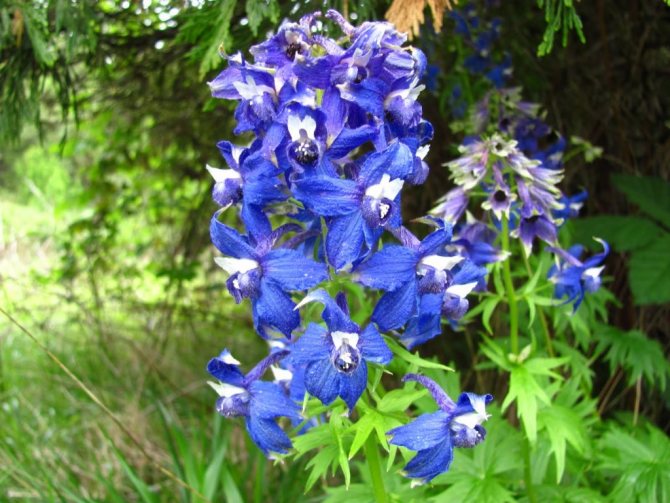

No Delphic magic! - Only flowers, grass and roots!
The ability to block pain by relaxing the muscles, has made comfrey an indispensable medicinal plant in the treatment of sore joints, bone fractures and relieve headaches and toothaches.
Decoctions, balms and poultices from larkspur are a pure miracle for backache (lumbago) and duck (rheumatism).
The juice of the root of the spur, mixed with honey, raised even seriously ill patients from their deathbed, and the same composition successfully cured consumption (tuberculosis).
back to menu ↑
Read also: Ageratum: description, planting in open ground and caring for it at home (30+ Photos & Videos) + Reviews
Choosing a place for the delphinium
The spur loves well-lit areas, but grows well in lace shade, or with partial shade during the day. Strong gusts of wind can break tall peduncles, so the plants are placed in places protected from the wind.
The plant prefers sandy loam or loamy soils, well-drained and fertile. On heavy wet soils, soils with an acidic reaction, delphinium is not planted. Before planting a plant, the site is dug up, adding rotted manure or compost in an amount of 10 - 12 kg per 1 sq. meter. Mineral fertilizers for flowers or superphosphate are applied in a dose of 30-50 g per square meter.
Getting ready for winter
Before the onset of cold weather, be sure to prune all faded peduncles. But when trimming them, there is one nuance that you need to pay attention to. We cut them off almost flush with the soil, and the remaining stumps must be covered with soil.
Since the stems inside the plant are hollow, leaving them above the surface allows a large amount of moisture to accumulate, which leads to an increase in moisture in the root system and can lead to the formation of rot. But, if, when cutting, still leaving the length of the stem 20-25 cm, then cover the holes with clay.
The plant is frost-resistant, but still, with a cold, little snow winter, it will not be superfluous to cover it with spruce branches.
Watering delphinium seedlings
Delphiniums do not like waterlogging of the soil. Excess moisture can cause decay of the rhizome, but even if this disease bypasses the plants, overflow will cause large areas without flowers to appear in the inflorescences. Due to such "bald spots" the plants will lose their decorative effect.
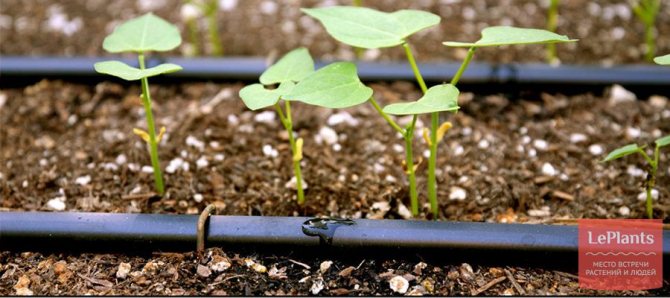

ON THE PICTURE: Automatic drip irrigation of seedlings or young plants is perhaps the most convenient way to organize watering.
Watering delphiniums should be abundant during drought and after each fertilization. A solution of minerals will only be beneficial if it saturates the soil to the roots. In other cases, water should be regularly and moderately, not too often or shallowly.

